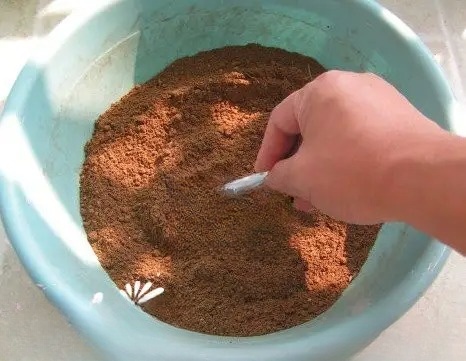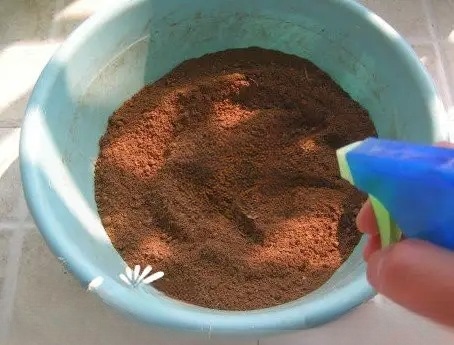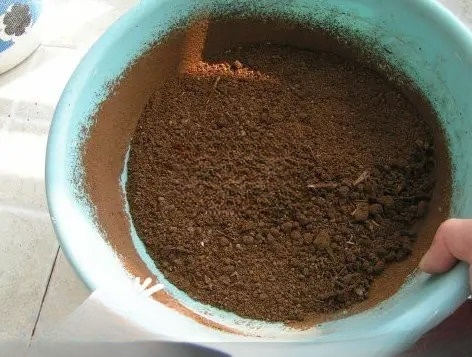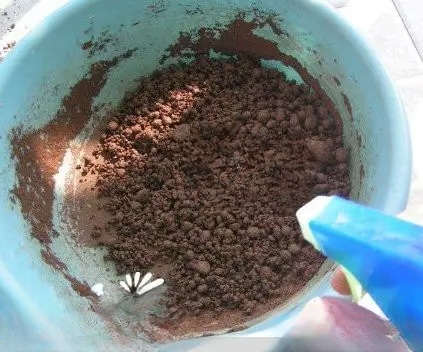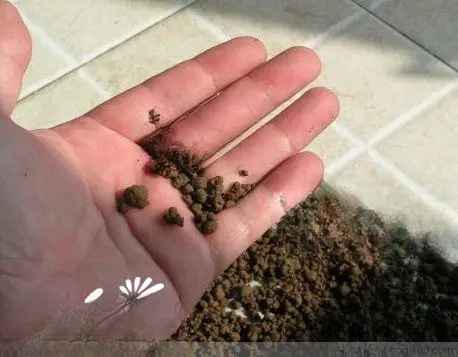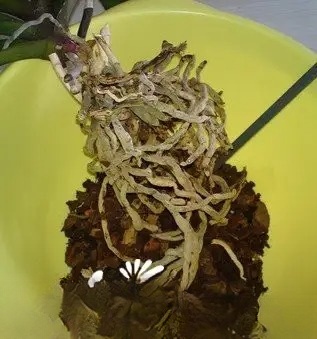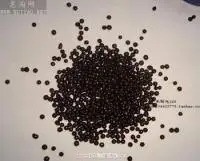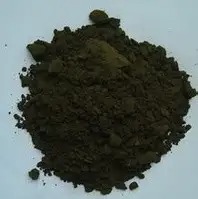Homemade hydroponic nutrient solution - simple and affordable
1. First, bring your basin, other pots and jars will also work, or a non-leaking handbag. (The basin doesn’t have to be new, it’s just for the sake of beauty)
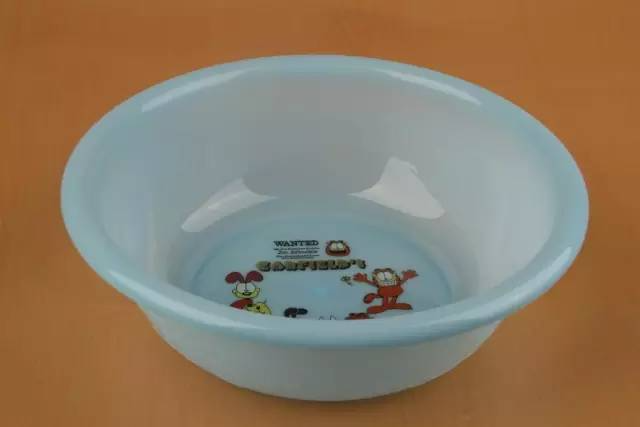
2. Find a place where you can dig the soil. You can go to some woods or other places where there are a lot of fallen leaves, because the fallen leaves will accumulate a lot of nutrients after they rot!

3. Use the shovel in your hand to dig up the soil about ten centimeters thick on the ground and put it into your pot. The more the better. (As long as the soil on the surface is the cultivated soil, as the farmers say. The soil at the bottom is raw soil, which has little nutrients.)
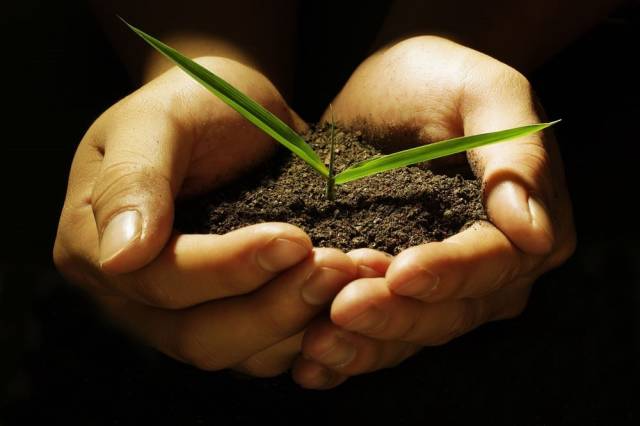
4. Bring the soil home, pour it into a basin (any container that does not leak will do), put it under the faucet, fill it with water, stir it with a wooden stick, and let it sit after stirring evenly.
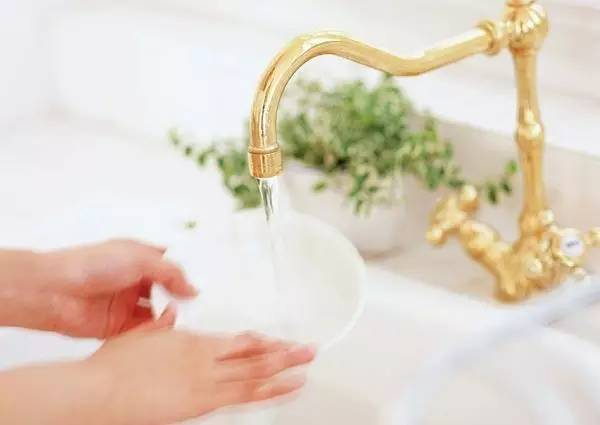
5. After about 30 minutes, the water will be a little turbid, but the nutrition is the best. If you think it is too turbid, just leave it alone.
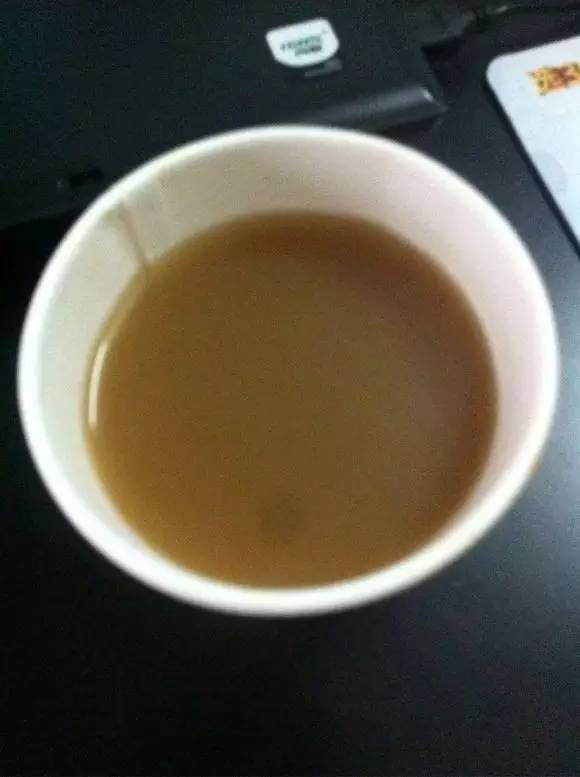
6. When the water is clear, you can pour out the supernatant from the basin and use it for hydroponics. This is what we want - nutrient solution.
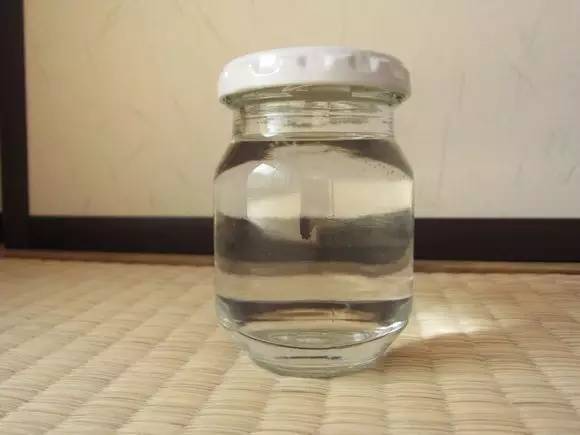
The hydroponic plant nutrient solution formula introduced below is a widely used formula - Morad nutrient solution formula
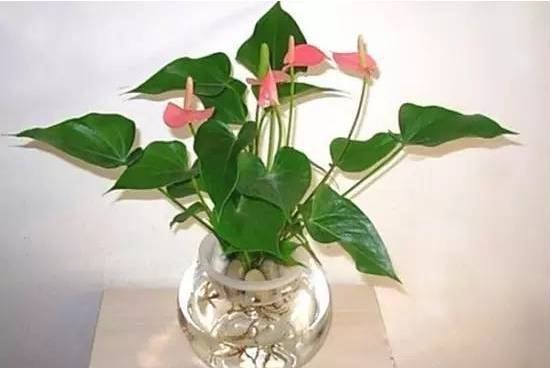
Liquid A: 125g calcium nitrate, 12g ferrous sulfate. Add the above into 1kg water.
Liquid B: 37g magnesium sulfate, 28g ammonium dihydrogen phosphate, 41g potassium nitrate, 0.6g boric acid, 0.4g manganese sulfate, 0.004g copper sulfate, 0.004g zinc sulfate. Add the above into 1kg water.
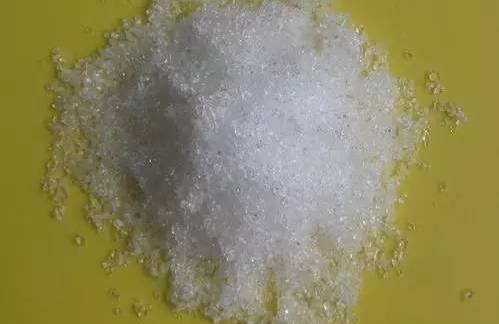
Preparation process of nutrient solution:
1. Weigh various fertilizers separately and place them in clean containers or plastic film bags.
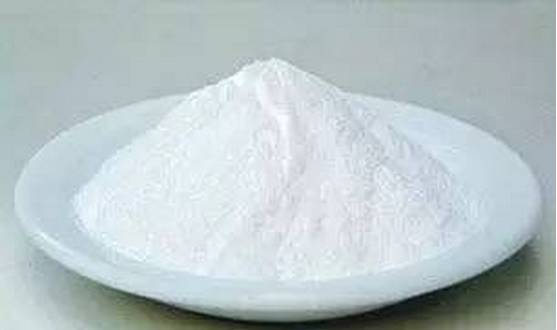
2. When mixing and dissolving fertilizers, pay strict attention to the order, otherwise it will cause precipitation and destroy the fertility.
① Dissolving order of liquid A fertilizer: first dissolve ferrous sulfate in warm water, then dissolve calcium nitrate, adding water and stirring until dissolved evenly.
② Dissolving order of liquid B fertilizer: dissolve magnesium sulfate first and then add diammonium phosphate and potassium nitrate in sequence, add water and stir until completely dissolved, dissolve boric acid in warm water and add it, and then add the remaining trace element fertilizers separately.
③ Mix liquids A and B separately and set aside.
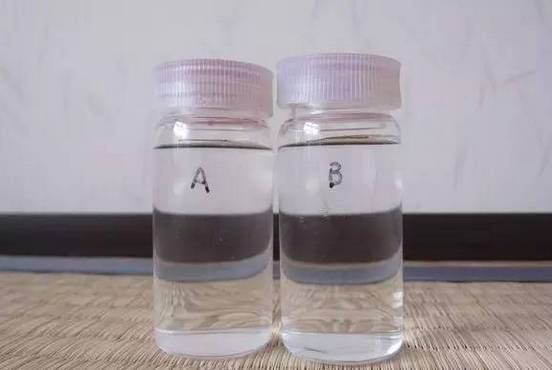
3. When using the nutrient solution, first take 10 ml of mother solution A and dissolve it in 1 kg of water, then add mother solution B to the 1 kg of water and it is ready for use.
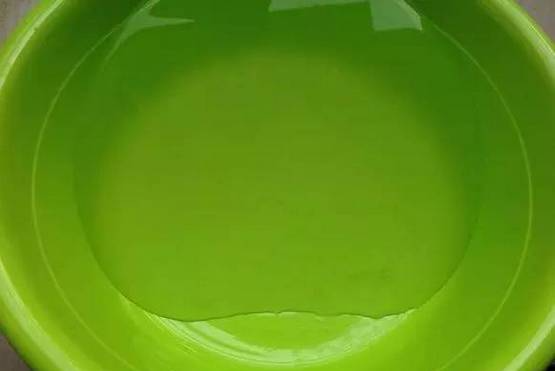
Specific usage
During the growth period of potted flowers, water the nutrient solution once a week, and the amount can be flexibly controlled according to the size of the flower plants.
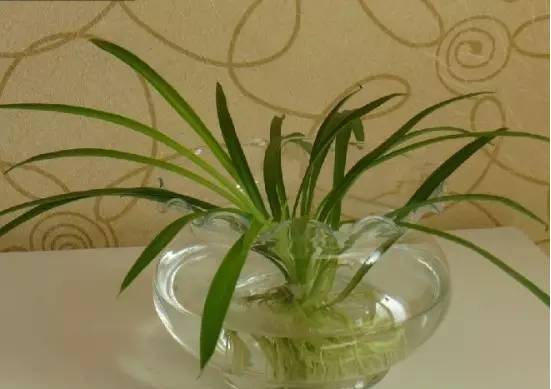
Notice
1. Do not use metal containers to prepare and store nutrient solution. It is best to use ceramic, plastic, glass or ceramic containers.
2. Use a micro submersible pump or an aerator to aerate the nutrient solution. The plant roots can obtain sufficient oxygen in such an environment, promoting the healthy growth of flowers.
The easiest way to make your own nutrient solution
The biggest difficulty of hydroponics is the lack of nutrients in the water. The longer the time, the weaker the plants. Adding nutrient solution is necessary.
One of the simplest methods is
to purchase some ordinary nutrient soil or garden soil, soak it in water for 24 hours, collect and control the water. After a long period of sedimentation, take the clear water on top, which is the simplest nutrient solution. The amount of water is controlled by yourself, and the amount of nutrient solution is determined appropriately. One nutrient soil can be used multiple times.
A good filtering method: Cut off the top of a mineral water bottle and turn it upside down to form a funnel. Put two layers of toilet paper inside as filter paper and you can filter.
The water will become clear after filtering. This nutrient solution does not need to be diluted and can be used for hydroponics.
Nutrient solution can be purchased ready-made, but it is difficult to prepare it yourself with chemicals, and the amount is difficult to control.
When preparing nutrient solution at home:
you can prepare the required nutrient solution according to your own needs and according to the formula. The required nutrient solution may not be available on the market. The main components of the nutrient solution are water (up to 99.6% or more), inorganic salts (of course, organic fertilizers are sometimes used. For example, urea, an organic nitrogen fertilizer, can only be effectively absorbed and utilized by plants after being converted into an inorganic state) and complexes.
Inorganic salts mainly refer to several salts of N, P, K, Ca, Mg, S, Cu, Zn, Mn, B, Mo, and Cl.
Complexes are mainly iron salts (some trace elements such as Zn and Mn can also be made into complex salts for use, but iron salts are necessary). It is better to add them when preparing the working solution.
If you want to prepare them in full, the commonly used ones should contain nitrate, sulfur, phosphoric acid, calcium hydroxide, potassium, and sodium within 30 varieties (mostly used in preparing working solutions and managing nutrient solutions to adjust pH, etc.). The calcium nitrate I use is made by myself by reacting nitric acid with calcium carbonate. If calcium hydroxide is used instead of calcium carbonate to get calcium nitrate, the purity is higher than that of calcium carbonate reaction (when I have time, I will also use nitric acid to react with nitroglycerin to play with it). Magnesium sulfate is bought as medical magnesium sulfate
at 6 yuan/kg. The most expensive one is molybdenum fertilizer, and the most dangerous ones are several strong acids and strong bases. When storing these raw materials, you must follow the relevant regulations. It
can be simplified, such as: you can prepare the nutrient solution without following the formula, as long as the plants grow well and there is no deficiency or excess of nutrients. It can also be rigorous, such as: if conditions permit, you can formulate the nutrient solution according to the results of the leaf analysis of plants with good growth and other factors, and modify it according to the actual situation of the trial planting.
You can clearly know the content of each element in the nutrient solution (at least before use) and the form of the elements used (such as: some plants prefer ammonium nitrogen and some plants prefer nitrate nitrogen). It
can be prepared and used immediately. It better solves the adverse effects of improper storage or storage time on the nutrient solution (reserve solution, working solution).
It is also a kind of fun. :)
The various elements and dosages used in preparing the nutrient solution should be determined according to the variety of flowers to be cultivated, their different growth periods, different regions, etc. There are many formulas of nutrient solutions currently used at home and abroad. Now we will only introduce the formula of the Hamp nutrient solution suitable for general potted flowers as follows: add a large number of elements per liter of water: 0.7 grams of potassium nitrate, 0.7 grams of calcium nitrate, 0.8 grams of superphosphate, 0.28 grams of magnesium sulfate, 0.12 grams of iron sulfate, 0.6 milligrams of trace elements boric acid, 0.6 milligrams of manganese sulfate, 0.6 milligrams of zinc sulfate, 0.6 milligrams of copper sulfate, and 0.6 milligrams of ammonium molybdate. The pH value of this formula is 5.5-6.5. When preparing, it is best to first use a small amount of warm water at about 50°C to dissolve the inorganic salts listed in the above formula separately, and then pour them one by one in the order listed in the formula into water equivalent to 75% of the specified capacity, stirring while pouring, and finally add water to the full amount (1 liter), which is the prepared nutrient solution. When preparing the above solution, the type and amount of elements can also be appropriately increased or decreased according to the different requirements of different flowers. Do not use metal containers when preparing or storing nutrient solution, but use ceramic, enamel, plastic or glass containers to avoid chemical reactions. When the amount of nutrient solution used for home flower cultivation is not large, in order to reduce the trouble of preparing nutrient solution, you can go to the flower and tree store to buy long-lasting flower fertilizers, such as plastic composite series flower fertilizers, vermiculite composite flower fertilizers, granular composite flower fertilizers, etc. In the northern region, you can also use a nutrient solution made by adding 0.22 grams of ammonium phosphate, 1.05 grams of potassium nitrate, 0.16 grams of ammonium sulfate, 0.16 grams of ammonium nitrate, and 0.01 grams of ferrous sulfate to 1 liter of water. You must think it is troublesome to mix each element. In fact, we have a ready-made nutrient solution around us - that is the mineral
water
we often drink. It is much easier to buy mineral water containing the above ingredients in the instructions. Some ingredients, such as ferrous sulfate, are very easy to obtain. Black Rock Reef only costs 1 yuan for one generation, and we can't use it up in two years!
How to make your own fertilizer?
In daily life, there are many waste materials that can be used to make fertilizers. (1) Soaking liquid fertilizer. Put waste vegetable leaves, melon and fruit peels, chicken and fish offal, fish scales, waste bones, eggshells and moldy food (peanuts, melon seeds, beans, bean powder*) in a small jar (or pot), add water and sprinkle a little trichlorfon, cover tightly, and use it after high-temperature fermentation. When using, take the supernatant and dilute it with water before applying. Alternatively, you can mix the above waste with some old culture soil, add some water, put it in a large plastic bag, tie it tightly and leave it for a while, and use it after fermentation. (2) Waste composting. Choose a suitable location to dig a pit with a depth of 60 cm to 80 cm, pad it with 10 cm of furnace ash, put rotten vegetable leaves, poultry and livestock viscera, fish scales, chicken and duck feces, eggshells, meat waste and broken bones in the pit, sprinkle some pesticides, cover it with a layer of garden soil about 10 cm thick, and keep the pit moist to promote fertilizer decomposition. It is best to compost it in autumn and winter. When it is heated up and decomposed in spring without foul-smelling gas, it can be mixed into the culture soil as basal fertilizer. It can also be sieved through a 4 mm sieve while still wet and rubbed into pellets. The fine ones can be used as top dressing, and the coarse ones as basal fertilizer.
The formula of soilless vegetable culture medium
Q: I want to engage in soilless vegetable cultivation. Can you recommend several soil cultivation substrate formulas? Thank you
Soilless cultivation technology of vegetables
Soilless vegetable cultivation can not only improve the yield and quality of products, but also does not occupy arable land, saves fertilizer and water, simplifies the process, and is conducive to the modernization and automation of vegetable production. Its cultivation technology is:
1. Select the substrate. The substrate should be low-cost, breathable, good in performance, strong in rooting and water-retaining. Generally, inorganic granular substrates such as slag and gravel are better. Slag is light, easy to carry, and has good water-retaining capacity. It is suitable for rooftops, balconies, and bungalow roofs. Gravel is more stable, easy to clean, easy to disinfect, has poor water-retaining capacity, is heavy, and is not easy to carry. It is suitable for use in courtyards and open fields. Generally, the particle size is 0.1-0 .5 mm、1.0-2.5 mm、2.5-5.0 mmThe three-level particles are mixed in one third each, and the total porosity can reach 45-50 %, of which air pores account for 25 % . The matrix used multiple times should be sieved and placed in a pool or suitable container, stirred continuously, rinsed with running water to float away residual roots and dirt, and then added with 0.1 % potassium permanganate or 0.1 % formalin solution to soak for 12-24 hours, and rinsed with running water before use.
2. Cultivation technology: Soilless vegetable cultivation requires cultivation bags, generally 0 .1 mmThick,70cmWide white polyethylene tube plastic bag, folded into double layer, tied with ropes on both sides, deep20cmThe cross section of the cultivation bag is " U ". According to the size of the cultivation site, prepare the corresponding number of cultivation bags, fill them with substrates, and place them neatly. Every three rows of bags are placed close together to form a 90- meter wide cultivation bag.-120 cmEach small bed is planted with 3 rows of vegetables, that is, one row of vegetables is planted in each bag, leaving 1/3 of the space between the beds.60cmWide channels are provided to facilitate the application of nutrient solution and manual management.
3. Preparation of solution In order to make full use of limited area and equipment, intercrop and interplant different varieties of vegetables, and improve the multiple cropping index, it is necessary to prepare nutrient solution to meet the growth and development needs of various vegetables. The method of preparing nutrient solution is to put the selected fertilizer into a selected container, add a certain amount of water, and keep the water level above the container mouth.20cmFor fertilizers that are difficult to dissolve, you can dissolve them with hot water first, then put them into a container and add appropriate amount of water. Stir well to make the water and fertilizer liquid synthesize nutrient solution. The concentration of nutrient solution should not exceed 0.2 %, and the pH value should be between 5.5 and 6.5 . Due to the evaporation of water and the absorption of nutrient ions by crops, the concentration and pH value of nutrient solution often change, so they should be tested and adjusted frequently, usually once every 7-15 days.
4. Watering management After soilless vegetables are planted, fertilizer is generally not added to the substrate, and nutrient solution can be used directly for watering. According to the size of the plant and the cultivation season, intermittent, regular, and quantitative nutrient solution is used. In the early stage, less nutrient solution is used. As the plant grows and the temperature rises, the amount of nutrient solution should be appropriately increased. Watering should be done 2-3 times a day. It is best to use a watering can. It is advisable to keep the substrate moist, but not excessive, so as not to cause root hypoxia and damage the roots. The suitable temperature of the nutrient solution is 20-25℃The relative humidity should be maintained for 2.5 hours during the day , the air content of the nutrient solution should be adjusted to 50-60 %, and 80-85 % is appropriate at night. The humidity is controlled at 15-30 %, which is generally higher in the morning and lower in the afternoon and night. This is conducive to the accumulation of organic matter and the healthy growth of plants.
In soilless vegetable cultivation, in order to prevent flowers and fruits from falling and regulate plant growth and development, biological hormones can be used comprehensively, such as spraying ethephon, chlormequat, 920 , and yield-increasing spirit, with appropriate concentrations and uniform spraying. For pest control, in addition to selecting disease-resistant varieties and seed disinfection, strong seedlings can be cultivated, humidity can be reduced, ventilation can be provided, and comprehensive prevention and control technical measures combining biological agents and chemical agents can be adopted. The alternating use of multiple agents has significant effects and high efficacy.
People who have been planting flowers for many years know that bamboo root soil is very fertile, but it is difficult to get. Why? Because bamboo roots are intertwined and grow horizontally. If you want to get some soil, you have to break the roots first. For bamboo farmers, digging their bamboo roots is equivalent to digging the roots of their walls. It is absolutely not allowed, so this kind of soil is very rare in the world. Lao Jiang is close to the water and has met the owner of the bamboo mountain by chance, so he dares to go there in a big way. This kind of soil is submerged under rotten bamboo leaves all year round. When a group of soldiers dig it, it squeaks and oozes oil (of course, that is impossible), but just by the touch that never feels greasy or dry, you know that this soil is the best for growing flowers .
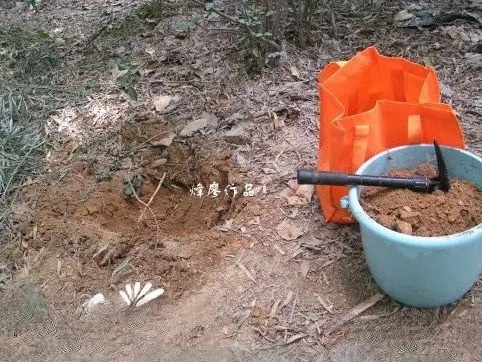
Take a closer look, this is the legendary bamboo root soil, freshly dug, with a purity of 99.99%.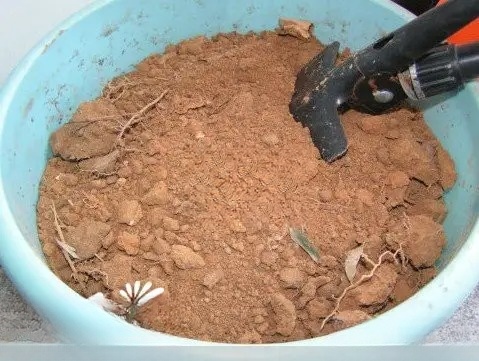
In the bamboo forest, the soil is relatively dry due to the action of the soil and bamboo roots. When the soil is dry, there are fewer insects and bacteria. This is also a major advantage of bamboo root mud. No sieving, no drying, no insecticide. Just rub it with your hands and pick out the fallen leaves, and the soil is ready for processing.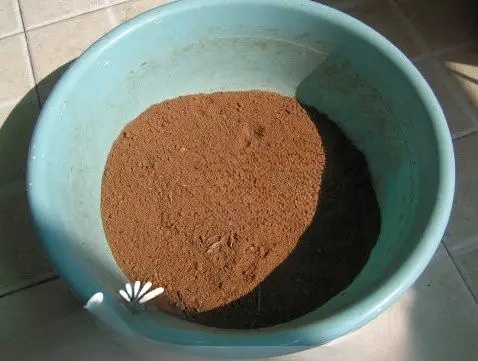
Add some more ingredients (depending on what you are planting, add what you like)
Stirring
Spray some water
Shake the bowl clockwise (similar to the process of rolling dough)
Keep shaking
The soil particles are too small, spray some water and continue shaking
Shaped and dried. Its appearance is similar to Akadama, but its ingredients are definitely better than Akadama.
The drying process is very important, it must be completely dry, otherwise the durability of the particles will be affected. After it is completely dry, you can store it for later use.
The method of use refers to the use of commercial Akadama soil, and try not to place it on the surface of the pot to avoid direct impact of water when watering. There are no other taboos.
How to repot flowers? Tips for repotting flowers
March and April are good times to repot potted flowers at home. The city's garden flower cultivation experts remind flower lovers that as potted plants grow, repotting can make the size of the pots match the seedlings and improve the nutritional conditions for the growth of flowers and trees. However, there are many things to pay attention to when repotting.
Transplanting time is now
Usually potted flowers are repotted once a year or every other year. It is best to repot when the dormancy of potted flowers ends and new buds sprout, or when flowers and trees have just been moved from indoors to the balcony and have not yet sprouted. However, the transplanting time of different flowers and trees is slightly different. In the north, potted flowers are generally repotted from mid-March to mid-April.
Change the flower pot to the appropriate size
When repotting, you should choose a flowerpot based on the root width of the flower. It is more appropriate that the diameter of the flowerpot is 3 to 6 cm larger than the root width. You can also choose a flowerpot based on the crown size of the flower or tree. It is more appropriate that the crown diameter of the flower or tree is 20 to 40 cm larger than the diameter of the flowerpot. Some people like to use large pots to grow small flowers, thinking that planting small flowers in large pots can allow them to grow freely and avoid the trouble of repotting. In fact, doing so is very detrimental to the growth of flowers. Small flowers require less fertilizer and water, and large pots with more soil often make it difficult to control the amount of water and fertilizer, which in turn affects the normal growth of flowers.
Dehumidify new pots and sterilize old pots
When replacing a new pot, soak it in clean water for a day and night before planting flowers, scrub it, and dry it before using it to remove its dryness. When replacing an old pot, expose it to the sun for sterilization. Before reusing it, scrub the inside and outside of the old pot to remove any possible insect eggs. If necessary, spray it with disinfectant. Among flower pots, clay pots are better, they are cheap and have good air permeability; purple clay pots are exquisitely made, but their air permeability is not as good as clay pots; porcelain pots have poor air permeability; plastic pots are light, but their drainage and air permeability are poor.
Repotting operation is carried out step by step
Before repotting, you need to stop watering the flowers and trees for a few days so that the soil can separate from the pot wall. Before putting the flowers and trees into the new pot, you need to cut off some of the entangled roots and old roots, and also cut off the roots that are too long and injured. If there are too many damaged roots, you also need to cut off some leaves. Flowers and trees that have just been watered should not be repotted.
Careful maintenance and frequent application of thin fertilizer
Generally, if flowers and trees are repotted at the right time for transplantation, they can survive as long as they are maintained according to the general method. After repotting potted flowers, water them thoroughly once so that the potting soil can absorb enough water. Do not water them too often, and be sure to wait until the potting soil is dry before watering. It is best to spray water on the leaves once a day. Potted flowers that have just been repotted should be placed in a cool place, not exposed to the sun, and not placed in a windy place to avoid damaging the flowers. Flowers that have just been repotted should not be fertilized because the roots of the plants cannot absorb fertilizers immediately after transplantation. Wait until they grow new leaves or sprout new roots in the new pot, and then fertilize them according to the principle of applying thin fertilizers frequently.
Soybean meal soaking liquid = "" Soak soybean meal and water in a ratio of 1:10. After sealed fermentation for 7 to 10 days, dilute with 50 times water and spray for use. When using, the grease on the surface of the soaking liquid must be removed.
Wood ash soaking liquid Wood ash is the ash formed after burning firewood. It is a loose and quick-acting potassium fertilizer, generally containing 5% to 15% effective potassium. Soak the wood ash and water at a ratio of 1:100 for 24 hours before use. During use, it should be noted that wood ash is alkaline and cannot be mixed with acidic fertilizers and pesticides.
For livestock and poultry manure soaking liquid, add 1 part of pig manure, sheep manure or chicken manure to 10 parts of water, soak it in a tank for 24 hours, filter out the clear original liquid on the top, and dilute it with 20 times of water before use.
The inorganic fertilizer dilution can be soaked in 0.2% urea, 3% to 5% superphosphate, 0.5% potassium dihydrogen phosphate, etc., and then poured into the flower pot. It is best to use rainwater, snow water or soft water to prepare the nutrient solution. If tap water is used, it must be left for 1 to 2 days before the chlorine evaporates.
Preparation and use of common flower nutrient solution
1. Potassium nitrate 0.7 g/L, boric acid 0.0006 g/L, calcium nitrate 0.7 g/L, manganese sulfate 0.0006 g/L, superphosphate 0.8 g/L, zinc sulfate 0.0006 g/L, magnesium sulfate 0.28 g/L, copper sulfate 0.0006 g/L, iron sulfate 0.12 g/L, ammonium molybdate 0.0006 g/L. When using, mix the various elements together and add 1 kg of water to form a nutrient solution. When preparing, the type and amount of elements can be increased or decreased according to the different requirements of different flowers.
2. 5 grams of urea, 3 grams of potassium dihydrogen phosphate, 1 gram of calcium sulfate, 0.5 grams of magnesium sulfate, 0.003 grams of zinc sulfate, 0.001 grams of copper sulfate, 0.003 grams of manganese sulfate, and 0.002 grams of boric acid powder; add 10 liters of water and dissolve to make a nutrient solution. When using, water the potted flowers once a week during the growth period, and the amount used each time can be determined according to the size of the plant. For example, for positive-loving flowers with an inner diameter of 20 cm in the flowerpot, water about 100 ml each time, while the amount used for negative flowers can be reduced. In winter or dormancy, water once every half a month or one month. Ordinary water is still used for water replenishment.
Usage: Water the potted flowers once a week during the growing period. The amount of water used each time depends on the size of the plant. For positive flowers, water about 100 ml each time, while for negative flowers, water less. In winter or dormant period, water once a month. Use tap water for watering at other times.
Notes on preparing nutrient solution:
(1) Use glass, enamel, ceramic or other containers when preparing nutrient solution. Avoid using metal containers.
(2) When preparing, first use a small amount of warm water at 50 degrees Celsius to dissolve each element separately, then pour it into the water, stirring while pouring to mix thoroughly.
(3) When using tap water to prepare nutrient solution, a small amount of humic acid compounds should be added to treat the chloride and sulfide in the water. In rural areas, river water or lake water can be used directly for preparation.
Adjust the nutrient solution and pH:
If the pH value of the water used is neutral or slightly acidic, the pH value of the nutrient solution after preparation is close to that of the water source, and no adjustment is required. However, if the tap water used is alkaline as determined by pH test paper, phosphoric acid should be used to neutralize it. If it is strongly acidic, sodium hydroxide should be added to neutralize it to make it neutral or slightly acidic.
How to prepare hydroponic nutrient solution
There are three basic conditions for home static hydroponic flowers (or hydroponic flowers for short):
1. Choose plants that are closely related to aquatic plants, that is, plants that retain aquatic genes, and use them as static hydroponic flowers.
2. Choose a non-leaking, bottom-hole cultivation container that matches the size and style of the hydroponic flowers.
3. Use ion balanced absorption (appropriate ratio) to produce a low-conductivity nutrient solution that contains all the mineral nutrients necessary for the growth of flowers and plants.
The recommended recipe is as follows:
(I) Macroelements: 0.27 g calcium nitrate, 0.13 g potassium nitrate, 0.08 g potassium dihydrogen phosphate, 0.13 g magnesium sulfate.
(ii) Trace elements: Disodium EDTA 8.0 mg, Ferrous sulfate 5.0 mg, Manganese sulfate 1.4 mg, Boric acid 2.0 mg, Zinc sulfate 0.07 mg, Copper sulfate 0.04 mg, Sodium molybdate 0.09 mg.
(iii) Purified water: 1 liter (1000 ml).
The pH value of pH is 5.5 to 6.5, and the conductivity EC is <0.5 millisiemens/cm. Plant the selected flowers in a container and inject hydroponic nutrient solution to cultivate them, and they will become a static hydroponic flower with unique charm. It is best to use purified water to prepare the nutrient solution. Of course, drinking tap water can also be used to prepare the nutrient solution. They are all strictly treated, clean and hygienic, and meet the requirements of aseptic (few bacteria) cultivation. However, it must be fully noted that there are fewer impurities and germs in purified water, and basically no nutrients necessary for plants, while tap water contains unstable nutrients as the components in the water source change. Therefore, the nutrient solution prepared with purified water has stable and consistent components, while the nutrient solution prepared with tap water has unstable components. Liquid chlorine is used to disinfect tap water. If there is too much chlorine in the tap water, it is harmful to flowers and plants. A water purifier can be installed on the faucet. Release the tap water, store it in a bucket with a larger diameter and leave it for a few days, stir it with a wooden stick several times to dechlorinate. If you need to change the water urgently, you can add 3 to 5 grains of sodium thiosulfate (commonly known as baking soda) into 10 kg of tap water, stir evenly, which can also remove chlorine.
Most foliage flowers prefer slightly acidic soil environments, and their intolerance to alkalinity cannot be changed in hydroponics. Static nutrient solution cultivation must adjust the pH of the solution to a range of 5.5 to 6.5, which is beneficial for the flowers to absorb trace elements, their physiological metabolism is not disturbed, their growth is normal, and their leaves are green.Flower fertilizer cake fertilizer
Cake fertilizer is the residue left after the oil is extracted from the seeds of oil plants. These residues can be directly used as fertilizer. There are many types of cake fertilizers, among which the main ones are bean cake, rapeseed cake, sesame cake, cottonseed cake, peanut cake, tung seed cake, tea seed cake, etc. The nutrient content of cake fertilizer varies due to different raw materials and different oil extraction methods. Generally, the moisture content is 10-13%, and the organic matter is 75-86%. It is an organic fertilizer with a relatively high nitrogen content.
How to apply cake fertilizer
1) Cake fertilizer can be used as base fertilizer and topdressing fertilizer. Cake fertilizer must be broken up before application. If used as base fertilizer, it should be applied to the soil 7 to 10 days before sowing. It can be applied in strips or holes in dry land. After application, mix it with the soil and do not apply it close to the seeds to avoid affecting seed germination.
2) If used as topdressing, it must be fermented and decomposed, otherwise it will continue to ferment in the soil and generate high heat, which can easily burn the roots of crops. When used in paddy fields, it must be drained first and then evenly spread. Combined with the first tillage, the cake fertilizer is fully mixed with the soil, and then irrigated after 2 to 3 days. Shallow dry land is suitable for hole application or strip application.
3) The amount of cake fertilizer applied should be determined according to the soil fertility and crop varieties. For low soil fertility and fertilizer-tolerant varieties, more fertilizer should be applied; otherwise, the amount of fertilizer applied should be reduced. Generally speaking, for medium-fertile soil, cucumbers, tomatoes, sweet peppers, etc. should be applied at about 100 kg per mu. Since cake fertilizer is a slow-acting fertilizer, it should be used in combination with appropriate amounts of quick-acting nitrogen, phosphorus, and potassium fertilizers.
4) The application period of cake fertilizer is 7 to 10 days before planting for melons and solanaceous fruits as basal fertilizer, and 5 to 10 days after fruiting as topdressing fertilizer, it can be applied in trenches or holes between rows, and covered with soil after application. Sugarcane has a long growth period. In addition to using part of it as basal fertilizer, topdressing fertilizer can be applied in combination with the first intertillage, and topdressing fertilizer can be applied in combination with the second intertillage. Qinglianju | Flower Forum | Forum | Flower Community
5) Soybean cake, peanut cake, sesame cake, etc. contain more protein and some fat, and have higher nutritional value. They are concentrated feed for livestock and should be used to feed pigs first, and then use pig manure and urine to fertilize the fields. They have greater economic benefits than directly applying cake fertilizer.
Cleaning and maintenance of flower leaves
Potted plants, especially those with large leaves, are prone to dust during placement. On the one hand, dust will block the pores on the leaves, making it impossible for the plants to absorb water and oxygen from the air or evaporate excess water from the body to the outside world; on the other hand, dust will make the potted plants look dusty and stained after spraying water, which is very unsightly. Therefore, in daily maintenance, it is necessary not only to remove insects and diseases for potted plants, but also to remove dust in time, so that the green natural space can show its elegant style and it is also very beneficial to purify indoor air.
1. Time to clean the blades
The best time to clean the leaves is in the morning so that they have enough time to dry before nightfall to avoid the leaves being in a humid environment for a long time due to lack of sunlight and lower temperature at night.
2. How to clean the blades
The water spray method uses the impact force of the water flow from the sprayer to wash away the dust on the blades.
Wiping method: Use a sponge or cotton cloth dipped in water to gently wipe off the dust and mud on the blades repeatedly.
Brush method: Use a soft brush to clean the dust on the blades
Note: The first two methods are not suitable for cacti, succulents, and plants with hairy leaves. Once the leaves are wetted by water, it is difficult to evaporate. Even if you use a dry cloth to absorb the water, it cannot be guaranteed to dry in a certain period of time. Some water-sensitive flower buds, such as the flower buds of gerbera leaves and the pseudobulbs of Clivia leaves, should not be exposed to water, especially during the germination and bud formation period. Water will affect the development of flowers .
In addition, do not spray water directly on the flowers. Flowers will rot and wither when exposed to water, which will also cause low fertilization and affect flowering and fruiting. Spraying water on the leaves of potted flowers such as pomegranates, crabapples, fuchsias, and crape myrtles will cause the branches and leaves to grow too long. The latter two cleaning methods are recommended.
Four major factors in fertilizing potted flowers
Fertilization of bonsai and flowers is very particular. Too much fertilizer will cause the branches and leaves to grow too long. Lack of fertilizer will cause the branches to be thin and weak, the leaves to turn yellow, and they will be easily damaged by diseases and insects. Therefore, pay attention to the following tips when fertilizing:
First, the root systems of newly planted trees and flowers, those that have just been potted, or those that have just had their soil changed, are damaged, so it is not advisable to apply fertilizer for the time being.
In spring and summer, the growth season of potted flowers and trees is in full swing, so more fertilizer must be applied. After autumn, the growth of potted flowers and trees is slow, so less fertilizer should be applied. In winter, when flowers and trees enter dormancy, stop fertilizing. It is not advisable to fertilize on rainy days or around noon in midsummer when the temperature is high (fertilizer is easily lost on rainy days, and fertilization in hot weather is easy to damage the root system).
It is best to apply fertilizer on cloudy days, in the evening, or when the soil in the pot is slightly dry. Remove weeds and loosen the soil first, which is conducive to the infiltration of fertilizer water into the soil and accelerates the decomposition of fertilizer. But be sure to water thoroughly the next morning, commonly known as "returning water", which is conducive to the absorption of fertilizer water and avoids fertilizer damage.
Second, apply fertilizer frequently and in small amounts, and each time apply fertilizer in a sparse manner.
Generally speaking, from the beginning of spring to the beginning of autumn, apply thin fertilizer and water (70% water and 30% fertilizer) every 15 days; apply fertilizer once 30 days after the beginning of autumn, and stop applying fertilizer after the beginning of winter.
Third, it should be noted that the nutrients needed by potted flowers and trees are mainly nitrogen, phosphorus and potassium.
Nitrogen fertilizer promotes the growth of plant branches and leaves, such as peanut bran, bean cake, and ammonium sulfate; phosphorus fertilizer promotes bright colors and large fruits, such as superphosphate and bone meal; potassium fertilizer promotes root development and firm plants, such as potassium sulfate and wood ash. Therefore, it is necessary to apply them according to the growth of the plants, as well as the characteristics of the varieties and the growth conditions.
Fourth, it is best to use organic fertilizers for bonsai flowers.
Organic fertilizers are also called farmyard manure, such as human feces, poultry manure, bone meal, peanut bran, bean cake, various green manures, plant ash, etc. These fertilizers contain different components of nitrogen, phosphorus and potassium. Try not to use chemical fertilizers, because chemical fertilizers will leave acid or salt roots, and the potting soil will become acidic or alkaline, which will hinder the growth of plants.
In addition, fertilizer should be applied on the edge of the pot to prevent the fertilizer from being too close to the plant roots and causing root burn.
How to make your own ordinary culture soil
Generally , flowers like soil that contains organic matter, is fertile and loose, such as mountain soil and pond mud. But this kind of soil is hard to find in cities, and we can't just find some soil to pot or dig a hole in the yard to plant flowers. What to do? In fact, urban families don't have to worry about soil for growing flowers. They can take soil from the local area to make ordinary culture soil or improve soil, and there is no need to apply base fertilizer when using it. There are many ways, and here are some of them:
First, use coal ash, coal ash slag or coal smoke (collectively referred to as coal ash) from thermal power plants, mixed with half of garden soil to grow flowers, which can not only improve powdery soil, but also completely replace ordinary culture soil with the application of nitrogen fertilizer. Pick out large pieces and put the soybean-sized ones at the bottom as drainage layer, which has a very good effect. Coal ash contains nutrients such as phosphorus, potassium, calcium, magnesium, copper, manganese, and zinc.
The second is to collect piled soil from the roadside, roof ridges or the leeward side of the house, mix it with 20% coal ash and 10% to 20% sawn wood, and then add some finely chopped egg shells, bean skins, fruit peels, hair, bone meal, etc., keep it moist and pile it up for a period of time, or seal it in a plastic bag, and it will become ordinary culture soil with excellent fertility.
The third method is to use 80% vermiculite sold in building material stores and 20% decomposed and fermented donkey and horse manure, and mix them evenly to make ordinary culture soil.
Different types of flowers have different requirements for soil types and pH. Therefore, ordinary culture soil is only suitable for growing herbaceous flowers such as chrysanthemums and dahlias that generally require strong drainage and air permeability. When growing other flowers, it is necessary to take additional measures while using ordinary culture soil. For example, when growing woody flowers such as roses and hibiscus, it is necessary to add 20% weathered river mud; when growing acid-loving flowers such as camellia, lily, Milan, and azalea, it is necessary to add 0.2% sulfur powder; when growing flowers such as monarch, orchid, and strelitzia, it is necessary to add 30% Northeast mountain forest leaf humus; when growing orchids , it is necessary to add 70% Jiangsu and Zhejiang mountain mud; when growing cacti, in order to make the burrs bright and the flowers bright, it is necessary to add 10% of the wall soil or lime powder peeled off from the lime wall, and 30% of large sand particles are added to the golden lily, and the amount of leaf humus should be increased for the Euphorbia reginae.
Application of peat in gardening
Peat is also called "peat" or "peat coal". It is a product of the development process of swamps. It was formed in the Quaternary period. It is composed of the remains of swamp plants that cannot be completely decomposed and accumulated under watery anaerobic conditions. It contains a large amount of water and incompletely decomposed plant remains, humus, and some minerals. The organic matter content is more than 30% (foreign countries believe that it should be more than 50%), the texture is soft and easy to break, the specific gravity is 0.7-1.05, mostly brown or black, flammable and breathable, the pH value is generally 5.5-6.5, slightly acidic reaction, layered distribution, called peat layer. It is an important indicator of the speed and degree of development of swamps. It is a valuable natural resource. Peat is the coal with the lowest degree of coalification (the most primitive state of coal) and is an organic matter.
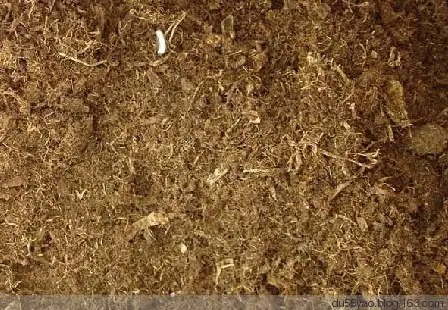
Because peat itself is rich in nutrients and is very beneficial to plants, it is widely used to build lawns, golf courses, football fields, tennis courts, green venues, grassland gardens and plant flowers . It is one of the best raw materials for compound fertilizers, so it is called "peat".
The various types of sites mentioned above often require special soil treatment before planting. Because "peat" has good drainage function and long fertilizer effect, it can promote the growth of underground roots and achieve the effect of correct color and strong plants.
Therefore, "peat" has a fundamental improvement effect on the "planting layer" of the soil, which is of great help to the later growth, care and maintenance of the lawn.
In addition, peat has many applications in potted seedling cultivation: "Peat" has become the production and cultivation of high-end flowers in current greenhouse potted plants. The ideal base material for potted flower cultivation is 30% to 70% "peat", mixed with an appropriate amount of vermiculite, perlite and other materials ( orchids , azaleas, Clivia and other flowers can be directly cultivated with 100% "peat"). Seedling cultivation: In the process of raising seedlings of flowers and vegetables, "peat" can be used as a medium material and a matrix structure to cultivate seedlings, which can greatly improve the germination rate of seeds and improve the development quality and survival rate of seedlings.
For soil that is compacted or hardened, whether it is for planting flowers, grass or other crops, adding an appropriate amount of peat can restore and improve the soil's ability to hold water, ventilate and retain fertilizer, and increase the nutritional content, thereby improving product quality and achieving better economic benefits.
Nutrient soil
Preparation of nutrient soil for growing flowers Garden soil: Garden soil is also called vegetable garden soil or farmland soil. It is common cultivation soil. Due to frequent fertilization and cultivation, it has high fertility and good aggregate structure. It is one of the main raw materials for preparing cultivation soil. The disadvantage is that the surface layer is easy to compact when dry, and the ventilation and water permeability are poor when wet, so it cannot be used alone. The surface sandy loam that has been planted with vegetables or legumes is the best.
1 Basic Introduction
In the production of substrate nutrient soil, leaf humus fermentation is a key step. In the past, the old-fashioned leaf humus production used primitive methods to pile and ferment the raw materials, which took as long as one or two years. The operation cycle was long, the maintenance cost was high, and the labor intensity was also high, which was no longer suitable for the needs of rapid commercial operation. Using Fuld microbial fermentation agent to make leaf humus completely solves the above problems.
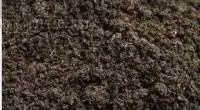
Fuerde microbial fermentation agent adopts Japanese biotechnology and contains a large number of functional microbial flora, which can quickly ferment organic materials. Using Fuerde biological fermentation agent to make leaf humus, fermentation is rapid, and generally the fermentation can be completed in about 20 days. Moreover, it effectively improves the physical and chemical properties of the soil and the microbial environment, promotes the normal growth and development of flowers and seedlings, makes the seedlings and flowers less susceptible to disease, less dead seedlings, and looks good, and is convenient for users to maintain, saving time and increasing economic benefits.
2 Main categories
Garden soil: Garden soil is also called vegetable garden soil or farmland soil. It is common cultivation soil. It is one of the main raw materials for preparing cultivation soil because it is often fertilized and cultivated, has high fertility and good aggregate structure. The disadvantage is that the surface is easy to compact when dry, and the ventilation and water permeability are poor when wet, so it cannot be used alone. The best surface sandy loam soil that has been used to grow vegetables or legumes is the best.
Leaf humus: Leaf humus, also known as humus soil, is a kind of culture soil made by mixing various plant leaves and weeds with garden soil, adding water and human feces and urine, and then piling up, fermenting and decomposing. The pH value is acidic. It needs to be exposed to the sun and sieved before use.
Mountain mud: This is a natural humus-containing soil with loose and acidic soil. Compared with black mountain mud, Huangshan mud has a heavier texture and contains less humus. Mountain mud is often used as the main culture soil material for acid-loving flowers such as camellia, orchids, and azaleas.
River sand: River sand has good drainage and ventilation. When mixed into heavy clay soil, it can improve the soil physical structure and increase soil drainage and ventilation. The disadvantage is that it has no fertility. It can be used as a material for preparing culture soil, or it can be used alone as a cutting or sowing medium. When sea sand is used as culture soil, it must be washed with fresh water, otherwise the salt content will be too high, affecting the growth of flowers.
Rice husk ash and plant ash: Rice husk ash is the ash from burning rice husks, and plant ash is the ash from burning rice straw or other weeds. Both are rich in potassium fertilizer. Adding them to the culture soil can make it well-drained, loose soil, increase the potassium fertilizer content, and make the pH value alkaline.
Bone meal: Bone meal is a fertilizer powder made by grinding and fermenting animal bones. It contains a large amount of phosphorus fertilizer. The amount added each time should not exceed 1% of the total amount.
Sawdust: This is a new culture material developed in recent years. It is loose and breathable, has good water retention and permeability, strong heat preservation, light weight, clean and hygienic. The pH value is neutral and slightly acidic. It can be used as culture soil alone, but the source of sawdust is not wide, and it cannot fix plants when used alone. Therefore, it is often mixed with other materials to increase the drainage and permeability of the culture soil.
Use pine leaves to prepare culture soil: Under larch trees, a layer of fallen leaves accumulates every autumn and winter. Larch leaves are small, light, soft, and easy to crush. After a period of accumulation, these fallen leaves can be used as materials for preparing culture soil, which is particularly ideal for cultivating azaleas. Larch can also be used as a material for preparing acidic or slightly acidic culture soil, as well as for improving looseness and permeability.
3 Preparation method
Mountain soil: garden soil: humus: rice husk ash (wood ash) is equal to 2:2:1:1, or garden soil: compost: river sand: wood ash is equal to 4:4:2:1. This is a light fertilizer soil suitable for general potted flowers, such as poinsettia, chrysanthemum, begonia, asparagus, cineraria, geranium, etc.
Mountain mud: humus: garden soil is equal to 1:1:4. This is a heavy fertilizer soil, suitable for acidic flowers such as Milan, kumquat, jasmine, gardenia, etc.
The ratio of garden soil: mountain mud: river sand is 1:2:1 or garden soil: wood ash is 2:1, which is suitable for alkaline flowers such as cacti, prickly pear, and jewelweed.
The ratio of garden soil to rice husk ash is 1:1 or river sand alone can be used for cuttings or seed planting.
Nutritious soil: It is made of pure natural organic fertilizer earthworm manure as the matrix, and is refined with high-quality peat soil, coconut bran, perlite, river sand and other materials. It has good drainage, air permeability and water and fertilizer retention capabilities. It is not only clean, hygienic and odorless, but also can improve the soil, sterilize and inhibit soil-borne diseases, and make the plant roots grow vigorously. It is an ideal soil for various flowers and potted plants. At the same time, it is also very suitable for the cultivation of various fruits, vegetables and lawn seedlings.
4 Operation Method
1. Prepare materials and make piles. First, pile 10 cubic meters of fallen leaves of broad-leaved trees, crop straw, or green grass into large piles, and compact them as you pile to reduce the volume as much as possible;
2. Prepare nutrient solution. Then mix 2.5 kg of urea with 150-200 kg of water to make urea water, and evenly spread it on the fallen leaves (the water content of the fermented material is required to reach 60-70%).
3. Spreading and inoculation. After the urea water is soaked, cover it with a breathable cover and leave it naturally for 24 hours. The next day, evenly spray 3 kg of microbial fermentation agent on the piled broad-leaved tree leaves or crop straw, and grass, turning and spraying at the same time. This process is called "inoculation" (it is best to use a new small spray bottle or sprayer for spraying. Sprayers that have been sprayed with pesticides are prohibited to avoid killing the bacteria).
4. Turn over during fermentation. After inoculation, cover the pile with a breathable covering to block light and rain. Under normal circumstances, after the fermentation process begins, the temperature can reach 55-60℃ after 3-6 days of fermentation. At this time, turn the pile over once, and fermentation can be completed after 2-3 times.
The fermentation methods of Formula 2 and Formula 3 are roughly the same as those of Formula 1, but the fermentation times are different due to the different raw material formulas.
Users in dozens of provinces and cities across the country have proven that using Fuerde microbial fermentation agents to ferment various barks, straws, leaves, chickens, pigs and other livestock and poultry feces to make leaf humus is simple and easy, and the fermentation speed is fast. The leaf humus fermented by this method is an ideal soil material for seedlings and flowers. Leaf humus fermentation is a key step in the production of matrix nutrient soil. In the past, the old-fashioned leaf humus production used primitive methods to pile and ferment the raw materials, which took up to one or two years. The operation cycle was long, the maintenance cost was high, and the labor intensity was also high, which was no longer suitable for the needs of rapid commercial operation. Using Fuerde microbial fermentation agents to make leaf humus completely solves the above problems. Fuerde microbial fermentation agents use Japanese biotechnology and contain a large number of functional microbial flora, which can quickly ferment organic materials. Using Fuerde biological fermentation agents to make leaf humus can ferment quickly, and generally the fermentation can be completed in about 20 days. Moreover, it effectively improves the physical and chemical properties of the soil and the microbial environment, promotes the normal growth and development of flower seedlings, reduces the risk of disease and death of flower seedlings, and makes the seedlings and flowers look better. It is convenient for users to maintain, saves time, and increases economic benefits.
5. Material Proportion
The raw materials can be matched according to local conditions. The following are several typical ratios:
1. 10m3 of fallen leaves of broad-leaved trees (crop straw, grass, etc.), 2.5kg of urea (or 250kg of livestock feces and urine), 3kg of Fuld microbial fermentation agent, and 150-200kg of water;
2. 10m3 of coniferous tree fallen leaves (rice husks), 5kg of urea (or 500kg of livestock feces and urine), 4kg of Fuld microbial fermentation agent, and 200-300kg of water;
3. 2m³ of conifer bark, 1kg of urea, 1kg of Fuld microbial fermentation agent, and 75-100kg of water
6 Disinfection methods
6.1 Is disinfection required?
Generally, the culture soil for potted plants does not need special disinfection, as long as it is exposed to sunlight. This is because, on the one hand, the flowers themselves have a certain resistance; on the other hand, the soil contains a large number of microorganisms, and their activities gradually decompose many nutrients to maintain soil fertility, which is conducive to the growth of flowers and trees. High temperature disinfection or disinfection with chemicals can also be used, but the microorganisms are killed and the organic matter in the soil cannot be decomposed, which is not conducive to the absorption of flowers and trees. The culture soil used for cuttings and sowing must be strictly disinfected, because pathogens can easily invade the body of flowers and trees from the wounds of the cuttings, causing rot and affecting survival. For sowing, the resistance of newly born buds is very weak, and microorganisms often cause them to mold.
Commonly used soil disinfection methods: Boiling disinfection method is to put the prepared culture soil into a suitable container and boil it for 30 minutes. The chemical disinfection method mainly uses formalin disinfection. Sprinkle 40% formalin solution 4 ml to 5 ml per liter of culture soil, and then seal it to prevent air leakage. Leave it for 2 days before opening.
7. Make an impact
The influence of soil acidity and alkalinity on flowers
Soil acidity is expressed in pH. pH < 5.0 is strongly acidic, pH 5.0-6.5 is acidic, pH 6.5-7.5 is neutral, pH 7.5-8.5 is alkaline, and pH > 8.5 is strongly alkaline. If the soil pH is not appropriate, it will hinder the plant's absorption of nutrients because pH is related to the solubility of mineral salts. The effectiveness of mineral nutrients such as nitrogen, phosphorus, potassium, sulfur, calcium, magnesium, iron, manganese, molybdenum, boron, copper, and zinc varies with the strength of the soil solution's acidity and alkalinity.
Determination of soil pH: Take a small amount of culture soil, put it in a glass, add water at a ratio of soil: water = 1:2, stir thoroughly, dip litmus paper or wide pH test paper in the clear liquid, and the pH value can be known according to the color change of the test paper.
Adjustment of soil pH: When the acidity is too high, you can add some lime powder or increase the proportion of plant ash (rice husk ash is also acceptable) to the culture soil. When the alkalinity is too high, you can add an appropriate amount of aluminum sulfate (alum), ferrous sulfate (green vitriol) or sulfur powder. When applying nitrogen fertilizer, using ammonium sulfate can also reduce the alkalinity of the soil and increase the acidity. Fruit peels can also neutralize alkaline potting soil. Soak apple peels and apple cores in cold water and use this water frequently to irrigate the potting soil to gradually reduce the alkalinity.
8 Other Information
Homemade nutrient soil
First, prepare several pots with a diameter of between one and a half feet and two feet (depending on the amount required), cut a piece of unused gauze at home and put it in the pot. This is because there will be a hole at the bottom of the pot, and a piece of gauze is placed first to prevent the soil from leaking out; next, spread a layer of soil about 1 inch thick on the bottom; the third step is to cut the leaves and peels into pieces, put them in the pot and cover them with a layer of soil, and repeat this step until the entire pot is full; the last step is to sprinkle some water on the top of the soil. The amount of water must be controlled, not too much or too little. If the peel contains more water, such as watermelon, use less water.
After three months, stir the finished culture soil and you will have a pot of new soil full of nutrients. It is important to emphasize that if you want to put vegetable leaves or fruit peels into the culture soil, in addition to cutting them into pieces, you must wait until you have enough to cover a layer before putting them into the pot. As for the fruit peels that have been put in one layer, they must be covered with another layer of soil to avoid mosquitoes, insects or bad smells.
Share my method of making nutritious soil
There are more and more high-rise buildings in the city, and less and less land. It is not easy to dig some good soil, so I start to cultivate the soil myself in late autumn every year. I bought Beilei brand black vinegar soil online. This soil is very loose and good for growing seedlings, but not suitable for growing flowers and vegetables. Taking the opportunity to go to Gaochun, I dug a lot of red soil in the mountains. The red soil was sieved to filter out stones and impurities. The two kinds of soil were mixed, and insecticides and fungicides were sprinkled in it, and Beilei's bone meal was found. Two large watertight vats were put in, basically a layer of soil and a layer of various fertilizers (fish intestines, chicken intestines, sesame cake fertilizer left over from squeezing sesame oil at the door, pine needles...), and rice washing water was poured in. In this way, a vat of soil with nitrogen, phosphorus and potassium fertilizers was prepared, and then the mouth of the vat was sealed to allow these fertilizers to ferment inside. The reason for choosing to cultivate the soil in late autumn is that the weather is getting colder and fish intestines and other things will not stink. After cultivating for a winter, the vat was opened in the spring of the next year. A vat of moderately soft, oily and black nutrient soil was cultivated.
Before use, go to a pharmacy or drugstore to buy potassium permanganate, dissolve it in water, and water the soil thoroughly to achieve the effect of disinfection. Put it in the sun to dry, and then you can plant flowers and vegetables. The replaced soil is processed in the same way to form nutritious soil in turn. If you plant vegetables, turn the soil deeply for each crop of vegetables, put in well-rotted chicken manure, earthworm fertilizer and other mature fertilizers and granular fertilizers, water it thoroughly with rice water, and seal it with bubble film for a week to increase the fertility of the soil, and then sow the vegetable seeds to start a new round of planting. The vegetables grown in this way are organic vegetables that do not contain any chemicals and are safe to eat.
Homemade flower nutrient soil is convenient and affordable
The nutrient soil for potted flowers must contain sufficient nutrients, have good water, fertilizer, gas, heat and other properties, and be able to resist the growth and mixing of harmful microorganisms and other harmful substances. Flower farmers usually use dry chicken manure or other manure and garden soil to prepare flower nutrient soil. Because the selected organic fertilizer is not mature or not fully mature, it is very easy to cause root burn, seedling burn and pests and diseases. The biological organic fertilizer fermented with Jinbaobei biological fermentation agent can well replace other farmyard manure as flower nutrient soil. Jinbaobei biological fermentation agent (also known as organic material composting agent, microbial fermentation agent, etc.) refers to a composite microbial agent with special "magical" functions (in fact, it is not magical after scientific analysis) formed by high-tech methods, artificial special cultivation, selection, purification, rejuvenation and other processes. The main microorganisms that play a key role are bacteria, filamentous fungi, yeast, actinomycetes and other flora.
This decomposed organic fertilizer can effectively eliminate harmful microorganisms in the soil. At the same time, it contains the macro-elements and trace elements needed by flowers. It is non-toxic and pollution-free, will not burn roots or seedlings, and can prevent the soil in pots from becoming compacted. It also eliminates the disadvantages of traditional methods of using chemicals (such as formalin) or steam to sterilize the soil, which damages a large number of beneficial microorganisms in the soil. It can not only improve the environment but also provide the flowers with the nutrients they need. Adding about one-tenth of river sand and a small amount of Jinbaobei microbial fertilizer to it can make a nutrient-rich flower nutrient soil.
Teach you how to prepare nutrient soil
There are many materials suitable for preparing culture soil, and the following are currently commonly used.
(1) Plain sandy soil. Mostly taken from riverbanks. It has good drainage performance but no fertility. It is often mixed with other culture materials to facilitate drainage.
(2) Garden soil. It is soil taken from the surface of vegetable gardens, orchards, etc. It contains a certain amount of humus and has good physical properties. It is often used as the basic material for most culture soils.
(3) Leaf mold. Made from fallen leaves and dead grass. It has a high humus content, strong water retention and good permeability. It is one of the main materials for preparing culture soil.
(4) Mountain mud. There are two types of mud: black mountain mud and yellow mountain mud. They are formed by the long-term accumulation of fallen leaves from trees in the mountains. Black mountain mud is acidic and contains more humus; yellow mountain mud is also acidic and contains less humus.
(5) Peat soil. It is formed by the carbonization of peat moss. Due to the different stages of formation, it is divided into brown peat and black peat. Brown peat contains rich organic matter and has an acidic reaction; black peat contains more minerals and less organic matter, and has a slightly acidic or neutral reaction.
(6) Rice husk ash. It is the ash formed by burning rice husks. It is slightly alkaline, contains potassium, and has good drainage and air permeability.
(7) Manure soil. Made by mixing animal feces, fallen leaves and other materials with garden soil, sewage and other materials, it has rich fertility. In addition, pond mud, river mud, coniferous soil, turf soil, rotten wood chips, vermiculite, perlite and other materials are all good materials for preparing culture soil. The preparation of culture soil should be flexibly mastered according to the growth habits of flowers, the properties of the culture soil materials and local conditions. For general potted flowers, the commonly used culture soil configuration ratio is leaf mold (or peat soil): garden soil: river sand: bone meal = 35:30:30:5, or leaf mold (or peat soil), plain sandy soil, decomposed organic fertilizer, superphosphate, etc. are mixed and sieved at a ratio of 5:3.5:1:0.5 before use. The above culture soils are mostly neutral or slightly acidic, suitable for most flowers. When used to cultivate acid-loving flowers and trees such as camellia and azalea, about 0.2% sulfur powder can be added; when cultivating flowers such as cactus, about 10% of wall soil peeled off from lime walls can be added.
Homemade leaf mold
Leaf humus is a common material for cultivating potted flowers. In places with conditions, you can go to the forest in the mountains and directly dig leaf humus that has been weathered for many years. You can also make your own leaf humus. The method is: collect fallen leaves, weeds, etc. from broad-leaved or coniferous trees in autumn and pile them into a rectangular pit. When piling, put a layer of leaves first, then a layer of garden soil, and pile them up repeatedly for several layers, then irrigate with a small amount of sewage, and finally cover the top with a layer of garden soil about 10 cm thick. Open it once in late spring and midsummer of the following year, turn over and crush the pile, and then pile it up as it was. In warm climate areas, these piles can mostly be decomposed in late autumn. At this time, they can be dug out, further crushed and sieved for use. Two points should be noted when piling: First, do not press too tightly to facilitate air penetration, create conditions for aerobic bacteria activity, and thus accelerate the decomposition of the pile. Second, do not make the pile too wet. If it is too humid, ventilation will be poor. Under anaerobic conditions, anaerobic bacteria will multiply and move in large numbers, causing serious loss of nutrients and affecting the quality of leaf mold.
Homemade Nutrient Soil
Potted flowers require loose, fertile soil with comprehensive nutrition, good drainage and air permeability. The potting soil and fertilizer should be prepared according to the characteristics of the flowers and actual conditions.
Garden soil. Garden soil is rich in humus, fertile, loose, breathable and water-retaining.
Pond mud. Dig pond mud, air dry it and crush it into dark brown or gray-black soil. It is rich in organic matter and humus, and can be mixed with water when used.
Leaf mold . Collect fallen leaves and dead grass and pour them into a pit. Sprinkle a small amount of human feces or kitchen waste water to mix well, cover with soil and set aside. Miscellaneous bone meal. Calcine the bones, horns, hooves, etc. of livestock and poultry and grind them into fine powder. It contains rich phosphorus fertilizer and calcium, and is a high-quality flower fertilizer. Mix it into the potting soil.
Smoke-baked fertilizer. Stack straw or dead branches and leaves with garden soil layer by layer, cover with soil, but make sure it is breathable, then light a fire and burn slowly until the soil is black and dry, then crush and sieve for later use.
Rice washing water. Rice washing water contains nitrogen, phosphorus, potassium and other elements. Using it to water flowers can promote luxuriant branches and leaves and well-developed root systems.
Tea water and wood ash water. Tea water and wood ash water not only have comprehensive nutrients, but also can adjust the acidity of the soil and promote the growth of flowers.
Eggshells, fish scales and fish belly waste can be fermented and decomposed to become a flower soil fertilizer rich in phosphorus, potassium and calcium, with long-lasting fertilizer effect.
Boiled egg water. It is rich in calcium, potassium and other trace elements. Watering flowers after cooling can promote luxuriant branches and leaves.
Hair residue fertilizer. Chicken and duck feathers or messy hair, etc., after fermentation or directly buried in flower pots, are comprehensive and long-lasting flower fertilizers that can last for two years without topdressing.
Fruit and vegetable peels and leaves. Fruit peels or rotten vegetable leaves are mixed with 2 times the soil, and then placed in a pool or barrel for sealed fermentation. The decomposed soil can be used as topdressing for flowers or as potting soil for direct planting of flowers.
Chinese medicine residue. Waste gas residue is rich in nutrition, clean and hygienic, and has no odor. It is very effective as flower fertilizer after being decomposed, and can also be directly sprinkled on the surface of potting soil.
Spoiled milk. Adding spoiled milk to water and diluting it can make the flowers grow vigorously and colorfully.
There are many fallen pine leaves mixed with soil under pine trees, which must be rotted and fermented in a closed environment before they can be used as nutrients, especially for potted flowers. Otherwise, if you use them directly to plant flowers, and let the pine needles ferment and rot in the pots with watering, it will consume a lot of oxygen necessary for the roots of flowers, causing a large number of anaerobic bacteria to multiply in the pot soil, directly harming the roots of plants and causing root rot.
In nature, the topsoil of forest areas is mostly formed by fallen leaves that have been piled up and decomposed for many years. Pine needle soil is a type of leaf humus, which is formed by the accumulation and fermentation of leaves of coniferous trees. Pine needle soil contains more humus, is light, loose, breathable, has good drainage and fertilizer retention capabilities, and is acidic or weakly acidic. It is very good for potted flowers and is the preferred cultivation medium for high-end flowers such as Clivia. Of course, pine needle soil is soil that has been piled up and decomposed and fermented, not simply fallen leaves and soil.
The fallen leaves accumulated under the big trees are naturally piled up and rotted, which is called leaf humus or humus soil. Leaf humus is rich in nutrients, acidic, loose in texture, and granular in structure. It is a loosening agent for heavy clay soil. You can use local materials or collect fallen leaves and pile them up by yourself. After all the leaves are rotten, they can be sieved and used for sowing and transplanting seedlings. The leaf humus under deciduous broad-leaved trees is especially good. The pine needle soil under coniferous trees such as pine has less effective nutrients, but it is very loose and is especially suitable for planting rhododendrons and orchids.
Generally, the leaf mold under deciduous broad-leaved trees, after sifting and adding 10% fermented cake fertilizer powder, or mixing with 5% multi-element slow-release compound fertilizer granules, is an ideal home potting soil. It can be used to grow camellia, sasanqua, wintersweet, osmanthus fragrans, gardenia, Clivia, orchid, Milan, jasmine, white orchid, jasmine, pineapple and most foliage plants.
The culture soil should have a good aggregate structure and appropriate pH. A good aggregate structure can ensure that the soil is loose, and the water retention and permeability are good. The pH and texture of the soil also affect the growth of trees. Pine, cycad, azalea, gardenia, etc. prefer acidic soil, cactus, elm, boxwood, etc. prefer alkaline soil, while photinia, maple leaf, etc. prefer neutral soil. Pine trees prefer sandy loam with more sand, pomegranate, azalea, etc. grow better in slightly sticky heavy loam. Garden soil, plant ash, leaf humus, peat soil, Huangshan mud, yellow sand (yellow sand is preferably mountain sand), etc. are properly mixed to make a good culture soil. For example, when raising Milan, 2 parts of peat soil and 1 part of sand are used, or 2 parts of fertile garden soil and compost soil are used, and 1 part of sand is used.
How to quickly and easily get high-quality soil that is fertile, soft and permeable. I have recently learned that I edited the post to remind everyone that the soil made in this way is acidic. If you want to grow plants suitable for growing in alkaline soil, you can add wood ash water to make it alkaline. Thanks to @数码火甲 for the guidance. I hope that all the experts can give me more advice when they find problems. Thank you. A friend mentioned bean dregs. I tried it. Bean dregs... After a few days, white mycelium began to grow in the soil of the bag and it also gave off a bad smell. I sprayed it with carbendazim and water, opened the bag and dried it, and it was gone the next day.
Friends who have terraces at home can use bean dregs. If it is a closed balcony... use with caution!!! However, soybeans contain more phosphorus, which is beneficial to the growth of plants. If you are worried that bean dregs will stink, you can try peanut shells. The nitrogen, phosphorus, potassium, etc. in peanut shells are also listed word by word. I hope everyone will support it. I hope everyone will give more opinions and suggestions. If you don’t understand something, you can leave a message and I will reply one by one.
It's actually very simple, but I've described it in more detail and in a more wordy way. When I first started growing flowers and plants, the biggest headache for me was how to get the right soil. At the beginning, I took advantage of the road construction near my home to dig the thin and sticky soil (typical southern red soil) in the green belt. I remember that when I first used this kind of soil and put it in a pot, even a strong thing like creeper died... Later, I made up my mind to get good soil.
In the past two or three years, I have figured out a method to get high-quality soil. It is simple, environmentally friendly and fast. Let those hard soils become fertile soils~~~~ Now it is time to start making these soils (preparation work)
First: prepare a bucket of ordinary soil, the soil cannot be too wet (it’s fine as long as it can be stirred). As for the proportion of the things, you can decide it by yourself. Anyway, the soil cannot be less than 50%. I think 60-70% is best. It cannot be higher than 80%, unless the soil itself is okay.) After these three things are mixed, the soil permeability problem is basically solved, it can only be said to be basically.
Second: (In fact, the second step can be done first, and you can start collecting now) You must have planted a lot of annual flowers and plants, which often die after winter. Keep the remains of these plants, collect them, dry them, and crush them. Some flowers and plants that have died due to insect diseases or poor skills cannot be wasted, so let them nourish other flowers and plants.
Here I recommend some useful things, unwanted vegetable leaves, tea leaves left after drinking tea, sugarcane bagasse (this is highly recommended), cosmos straw (this is also highly recommended). These two highly recommended things can not only increase the fertilizer content, but also the key is to increase the softness. And so on, etc., everyone is welcome to add. The branches and leaves can all come in handy.
All these things should be dried, crushed, and cut into pieces. Collect them all. The more the better. In fact, it doesn’t matter if they are not dried. Just use scissors to randomly cut them into pieces. Drying and crushing are for better collection. We are in Changsha, Hunan. Camphor trees can be seen everywhere. Camphor trees shed their leaves in spring, growing new leaves while dropping old leaves, so they are just the right time to collect them. I don’t know if there are plants that shed their leaves in spring where you are. If not, you can only collect them in autumn (but if the things mentioned above are enough, the leaves are basically not needed, because this method itself should reflect its simplicity and convenience. Try to use materials that are available at home as much as possible. There is no need to dig or buy them outside). In fact, there is no need to collect the above things in large quantities at once. Just accumulate them little by little in daily life. When summer comes, the things in the previous two steps can be mixed together. Let’s start the third and fourth steps
Third: A small bag of fertilizer (the kind that costs four yuan a bag will do), and peat that some people complained about as rotten mud in the forum. Some forum users said that the Northeast peat is impermeable and not suitable for growing flowers and plants, but it should not be wasted (I have never used peat, but adding some should have a good effect)
Fourth: moss soil, dried moss (strongly recommended). You don’t need much (but more is better, because this resource is scarce, haha). For example, there is 10 years of moss soil accumulated in the gutter upstairs in my house. When it dries up after a few days without rain, you can directly peel it off piece by piece. You can never use it up. The dead dried moss can improve the softness and fluffiness of the soil.
Stir all the above things thoroughly. I believe everyone has done what I said above. The following is the key. Find a few extra large and strong plastic bags (supermarket shopping bags will do), pack them, seal them, and expose them to the sun in the summer. If the sun is strong enough, the soil can be basically used after about half a month (this is in a more urgent situation). Plastic bags are the most convenient materials to get. If you have the conditions, you can use covered fiberglass or the plastic film used to cover greenhouses to DIY a box. The disadvantage of plastic bags is that they are easy to break after being exposed to the sun for a long time, so it is recommended to use a plastic bag for only one summer.
Generally speaking, the best effect is to expose the soil to the sun for a whole summer. During this period, you can open the plastic bag and turn it over. You will find that the soil is very hot and probably cooked. You can also smell the aroma of the soil. If the soil is dry, you can spray some rice water appropriately and continue to seal it. During this period, you can also throw some broken leaves into it one after another and stir it. As mentioned above, the plants that died of pests and diseases, in fact, viruses and insect eggs will basically die automatically in this short time. If you feel uneasy, you can not use these, or dry them, burn them into ashes, and then mix them in. Believe in these soils, if there are enough in autumn sowing, you can save them for spring sowing. However, in winter, you can dig some moss and put it in it to let the moss grow in the bag. Maybe the soil you get for the first time will not be particularly high-quality, but it is definitely no problem to plant flowers. However, it is actually a great achievement to be able to bring that kind of hard soil back to life.
When the plants need to be repotted in the future, you can use this method to improve the soil generation after generation. The later it is, the better it will be. The key to this method is strong sunlight, otherwise it will be meaningless. Compared with soil fermentation, this method takes less time, does not require a large tank, and does not need to worry about stink. It can be continuously recycled to improve the soil, which is environmentally friendly and convenient.
By the way, one more thing to add: when sealing the plastic bag, do not press the bag tightly, do not press the soil tightly, leave some air inside, this is more conducive to raising the temperature, so just put half a bag of soil in each plastic bag. During the drying process, if there are any vegetable leaves, cut them into pieces, open the bag, throw them in and stir them, and seal them. Keep it moist and slightly dry, the soil should be fluffy or as big as beans. Do not let it become mushy because it is too wet. If this happens, open the bag, open it to dry, let some water in, and stir it a few times.
Since I am not a professional flower grower, I don't know much about pH and other pretentious things, so I still need to learn more. In fact, it is more convenient to buy a bag of professional garden soil, but without the process of making it yourself, the fun will be much less, and the nutrients in the garden soil will be slowly consumed. If you use this method, you can make the soil fertile. In the past two years, these soils of mine are already the second generation, and the amount of soil is slowly increasing (because I sometimes dig some soil back). Compared with the hard soil at the beginning, it has been a great improvement.
As the saying goes, hard work pays off. There is still more to learn in the future and experience is accumulated slowly. Regarding flowers and plants, my biggest wish is that every household will plant flowers and grass, plant them on the balcony, at the doorstep, and on the roadside, to make themselves and others happy, and to add liveliness and fun to our living environment.
The soil in the pot is very compacted, and there are rotten leaves. It is good to use this: soil, sand, rotten leaves 1:1:1. What flowers are suitable for pine needle soil? Pine needle soil has very good permeability and strong water permeability. It contains a lot of organic matter and is suitable for the cultivation of many flowers, such as rubber trees, palms, orchids, spider plants, various climbing plants, June snow, jasmine, camellia, pomegranate, amaryllis, and many other flowers that require loose soil, sufficient fertilizer, and no water accumulation. It is very suitable. According to the habits of flowers, pine needle soil and garden soil (loess, black soil) can be configured in different proportions to better play the characteristics and advantages of pine needle soil.
Provide a good environment. It depends on whether it is decomposed. If it is decomposed, most flowers and plants can be planted. Fully decomposed pine needle soil has a large amount of humus and certain bactericidal substances. It is not only nutritious but also has certain bactericidal ability when used to plant flowers. Generally, it depends on the degree of decomposition of pine needles. The more broken, the better! The color is dark brown (pay attention to whether it has been less fire. If it has been less fire, the nutrition will become relatively single). When planting flowers, you can add some soil, sand or pine bark, etc. The key depends on what flowers to plant!
If you are planting orchids, you can use slightly beaten soil (about 2/3 of pine leaves decomposed) and pine bark (the small pieces of dry bark on the tree) in a 1:1 ratio. If you are planting other flowers, you can use pine needles soil, river sand and soil in a 1:0.5:1 ratio (general) 2:0.5:1 (a little more fertile). You can make composted soil, but it is not suitable for making it in the north now. The method is to bury the fallen leaves with soil and sprinkle some water on it. It will take about half a month (in summer) (in winter, you need to cover it with a film, black color, and it is best to expose it to the sun for a month). You can directly buy nutrient soil. Depending on the color, there is composted soil made with pig manure.
The order of laying is this: if you use dry pine needles, then lay the pine needles at the bottom, slightly raise them, about 1/4, and then lay a layer of rotted soil (it is winter now, the temperature is low, and the rotted soil can brittle the pine needles indoors without burning the roots). Then sprinkle some ordinary soil or the sand you mentioned, and then lay some rotted soil, repeat until the roots are buried, and then sprinkle a thin layer of pine needles on top for moisturizing (it depends on your personal environment, you can skip the last layer of pine needles).
How to Make Flower Fertilizer
Good flower fertilizer can make flowers more colorful. Using household waste to make good flower fertilizer is both economical and environmentally friendly. These homemade fertilizers are organic fertilizers, containing a variety of nutrients and rich organic matter required by flowers. They have mild and long-lasting fertilizer effects, can also improve the soil, form a granular structure in the soil, and coordinate the air and water in the soil, which is extremely beneficial to the growth and development of flowers.
There are many materials suitable for preparing culture soil, and the following are currently commonly used.
1) Plain sand
It is mostly taken from river beaches. River sand has good drainage and air permeability, and is often mixed with other culture materials to facilitate drainage. Mixing it into heavy clay soil can improve the soil physical structure and increase soil drainage and air permeability. The disadvantage is that it has no fertility. It can be used as a material for preparing culture soil, or it can be used alone as a cutting or sowing medium. When sea sand is used as culture soil, it must be washed with fresh water, otherwise the salt content will be too high, affecting the growth of flowers.
2) Garden soil
Garden soil: Garden soil is also called vegetable garden soil or farmland soil. It is taken from the surface soil of vegetable gardens, orchards, etc. It contains a certain amount of humus and has good physical properties. It is often used as the basic material for most culture soils. This is ordinary cultivation soil. Due to frequent fertilization and cultivation, it has high fertility and good aggregate structure. It is one of the main raw materials for preparing culture soil. The disadvantage is that the surface layer is easy to compact when dry, and the ventilation and water permeability are poor when wet, so it cannot be used alone. The surface sandy loam that has been planted with vegetables or legumes is the best.
3) Leaf mold
Leaf humus: Made from fallen leaves and dead grass. It has a high humus content, strong water retention and good permeability. It is one of the main materials for preparing culture soil. Leaf humus, also known as humus soil, is made by mixing leaves and weeds of various plants with garden soil, adding water and human feces and urine, and then piling, fermenting and composting to make culture soil. The pH value is acidic. It needs to be exposed to the sun and sieved before use.
4) Mountain mud
Mountain mud: There are two types: Huangshan mud and Heishan mud. They are formed by the long-term accumulation of fallen leaves from trees in the mountains. It is a natural humus-containing soil with loose soil. Heishan mud is acidic and contains more humus; Huangshan mud is also acidic and contains less humus. Compared with Heishan mud, Huangshan mud has a heavier texture and contains less humus. Mountain mud is often used as the main culture soil material for acid-loving flowers such as camellia, orchids, and azaleas.
(5) Rice husk ash and wood ash.
Wood ash is the ash from burning straw or other weeds. Both are rich in potassium fertilizer. Adding them to the culture soil can make it well-drained, loose soil, increase the potassium fertilizer content, and make the pH value alkaline.
(6) Peat soil
Peat soil: It is formed by the carbonization of peat moss. Due to the different stages of formation, it is divided into brown peat and black peat. Brown peat contains rich organic matter and has an acidic reaction; black peat contains more minerals and less organic matter, and has a slightly acidic or neutral reaction.
(7) Manure soil
Stable manure soil: Made by mixing animal feces, fallen leaves and other materials with garden soil, sewage and other materials, it has rich fertility. In addition, pond mud, river mud, coniferous soil, turf soil, rotten wood chips, vermiculite, perlite, etc. are all good materials for preparing culture soil.
(8) Bone meal
Bone meal: Bone meal is a fertilizer powder made by grinding and fermenting animal bones. It contains a large amount of phosphorus fertilizer. The amount added each time should not exceed 1% of the total amount.
(9) Wood chips
Sawdust: This is a new culture material developed in recent years. It is loose and breathable, with good water retention and permeability. However, it is not wide and cannot fix plants when used alone. Therefore, it is often mixed with other materials to increase the drainage and permeability of the culture soil.
(10) Pine needles
Use pine leaves to prepare culture soil: Under larch trees, a layer of fallen leaves accumulates every autumn and winter. The leaves of larch are small, light, soft and easy to crush. After a period of accumulation, these fallen leaves can be used as materials for preparing culture soil, which is particularly ideal for cultivating azaleas. Larch can also be used as a material for preparing acidic or slightly acidic culture soil, as well as for improving looseness and permeability.
Several preparation methods of culture soil (for reference only)
Preparation of culture soil: It should be flexibly controlled according to the growth habits of flowers, the properties of the culture soil materials and local conditions. For general potted flowers, the commonly used culture soil preparation ratio is leaf mold (or peat soil): garden soil: river sand: bone meal = 35:30:30 5, or leaf mold (or peat soil), plain sandy soil, decomposed organic fertilizer, superphosphate, etc. are mixed and sieved at 5:3.5:1:0.5 before use.
The above-mentioned culture soil is mostly neutral or slightly acidic, suitable for most flowers. For the cultivation of flowers and trees that prefer acidic soil, such as camellia and azalea, about 0.2% sulfur powder can be added; for the cultivation of flowers such as cactus, about 10% of the wall soil peeled off from the lime wall can be added.
▲ Mountain soil: garden soil: humus: rice husk ash (wood ash) is equal to 2:2:1:1, or garden soil: compost: river sand: wood ash is equal to 4:4:2:1. This is a light fertilizer soil suitable for general potted flowers, such as poinsettia, chrysanthemum, begonia, asparagus, cineraria, geranium, etc.
▲The ratio of mountain mud: humus: garden soil is 1:1:4. This is a heavy fertilizer soil suitable for acidic flowers such as Milan, kumquat, jasmine, gardenia, etc.
▲Garden soil: mountain mud: river sand is equal to 1:2:1 or garden soil: wood ash is equal to 2:1, suitable for alkaline flowers such as cactus, prickly pear, jewelweed, etc.
▲Garden soil: rice husk ash is equal to 1: 1 or river sand alone can be used for cuttings or planting.
Precautions
Disinfection of potting soil: Generally, potting soil does not need special disinfection, as long as it is exposed to sunlight. This is because, on the one hand, flowers themselves have a certain resistance; on the other hand, the soil contains a large number of microorganisms, and their activities gradually decompose many nutrients to maintain soil fertility, which is conducive to the growth of flowers and trees. High temperature disinfection or disinfection with chemicals can also be used, but the microorganisms are killed and the organic matter in the soil cannot be decomposed, which is not conducive to the absorption of flowers and trees. The culture soil used for cuttings and sowing must be strictly disinfected, because pathogens can easily invade the body of flowers and trees from the wounds of the cuttings, causing rot and affecting survival. For sowing, the resistance of newly born buds is very weak, and microorganisms often cause them to mold.
Commonly used soil disinfection methods: Boiling disinfection method is to put the prepared culture soil into a suitable container and boil it for 30 minutes. The chemical disinfection method mainly uses formalin disinfection. Sprinkle 40% formalin solution 4 ml to 5 ml evenly on each liter of culture soil, and then seal it to prevent air leakage. Leave it for 2 days before opening.
The influence of soil acidity and alkalinity on flowers: Soil acidity and alkalinity are expressed by pH value. pH value <5.0 is strongly acidic, pH value 5.0 ~ 6.5 is acidic, pH value 6.5 ~ 7.5 is neutral, pH value 7.5 ~ 8.5 is alkaline, and pH value > 8.5 is strongly alkaline. If the soil acidity and alkalinity are not appropriate, it will hinder the plant's absorption of nutrients, because the acidity and alkalinity are related to the solubility of mineral salts. The effectiveness of nitrogen, phosphorus, potassium, sulfur, calcium, magnesium, iron, manganese, molybdenum, boron, copper, zinc and other mineral nutrients varies with the strength of the soil solution acidity and alkalinity.
Determination of soil pH: Take a small amount of culture soil, put it in a glass, add water at a ratio of soil: water = 1:2, stir thoroughly, dip litmus paper or wide pH test paper in the clear liquid, and the pH value can be known according to the color change of the test paper.
Adjustment of soil pH: When the acidity is too high, you can add some lime powder or increase the proportion of plant ash (rice husk ash is also acceptable) to the culture soil. When the alkalinity is too high, you can add an appropriate amount of aluminum sulfate (alum), ferrous sulfate (green vitriol) or sulfur powder. When applying nitrogen fertilizer, using ammonium sulfate can also reduce the alkalinity of the soil and increase the acidity. Fruit peels can also neutralize alkaline potting soil. Soak apple peels and apple cores in cold water and use this water frequently to irrigate the potting soil to gradually reduce the alkalinity.
Preparation of Several Kinds of Flower Fertilizers
1. Preparation of nitrogen fertilizer. Nitrogen fertilizer is the main fertilizer to promote the growth of roots, stems and leaves of flowers. Crush and boil the moldy and inedible beans, peanuts, melon seeds, castor beans, leftover vegetable leaves, bean shells, melon and fruit peels, pigeon droppings, and expired and spoiled milk powder, put them in a small jar, fill it with water, and then seal it to ferment and decompose (if conditions permit, sprinkle some pesticides).
To make it mature as quickly as possible, place it in the sun to increase the temperature. When all the substances in the jar sink, the water turns black and has no odor (about 3-6 months), it means that it has been fermented and matured. In summer, after 10 days, you can take out the upper fertilizer water and use it for water. It can be used as topdressing or directly as base fertilizer. After use, fill it with water and ferment again. The residue of the raw materials can be mixed into the flower soil.
2. Preparation of phosphorus fertilizer. Fish intestines, meat bones, fish bones, fish scales, crab shells, shrimp shells, hair, nails, livestock hoof horns, etc. are all debris rich in phosphorus. Crush these debris and mix them evenly in the flower soil, or put them in a container and ferment them to become ideal phosphorus fertilizer. Use them to water flowers, and the flowers will be colorful and bright, and the fruits will be plump. The fertilizer effect can last for more than 2 years.
Eggshell flower fertilizer, clean the eggshell, dry it in the sun, crush it, and then grind it into powder in a mortar. Mix 1 part eggshell powder to 3 parts potting soil, and plant flowers in pots. It is also a long-acting phosphorus fertilizer. Generally, during the watering process after planting, the effective ingredients will precipitate and be absorbed and utilized by the flowers. After planting flowers, the eggshell powder will bloom large and colorful flowers and produce large and full fruits. It is a completely organic phosphorus fertilizer.
3. Preparation of potassium fertilizer. Rice swill (preferably fermented before use), tea residue, milk bottle washing water, etc. are excellent potassium fertilizers and can be used directly to water flowers. Plant ash also contains potassium fertilizer and can be used as base fertilizer. Potassium fertilizer has a significant effect on improving the ability of flowers to resist lodging and diseases and pests.
Production of compound fertilizer
1. Preparation of complete compound fertilizer. Put the leftover bones of pork ribs, lamb ribs, beef ribs, etc. into a pressure cooker, steam them for 30 minutes, and crush them into powder. Mix them in a ratio of 1 part bone crumbs to 3 parts river sand, and use them as base fertilizer for flowers. Place them 3 cm below the bottom of the flower pot, cover them with a layer of soil, and then plant flowers.
2. Nitrogen-phosphorus compound fertilizer. Take 0.5 kg of ammonium carbonate, 0.15 kg of potassium chloride, 0.025 kg of zinc sulfate, 2.5 kg of human feces and urine, 1 kg of cow feces and urine (or 5 kg of pig feces and urine), and 20 kg of red stone bone powder, divide them into 5 equal parts, then spread a layer of red stone bone powder (4 kg), sprinkle other fertilizers on it, pat it tightly with a wooden board, and finally cover it with straw or film. After 20-25 days, it will become a nitrogen-phosphorus compound fertilizer.
3. Humic acid ammonium phosphate. Take 1 kg of decomposed biogas residue, add 0.05 kg of phosphate rock powder, mix well and pile into a pile, apply a 3-5 cm thick thin mud layer mixed with cow dung, and then sprinkle a layer of fine soil. Seal it for 40 days to make humic acid phosphate fertilizer. Then turn the humic acid phosphate fertilizer over and grind it, pile it again and apply thin mud, then make holes around the top of the pile and press 1000 to make it. This compound fertilizer is effective as a base fertilizer.
When using homemade flower fertilizer, you must follow the principle of "thin fertilizer and light application", dilute it appropriately, apply it in appropriate amounts, and avoid over-application. When fermenting fertilizer, you must wait until the fertilizer water inside turns black and is completely decomposed before pouring it out and mixing it with water (about 9 parts water to 1 part fertilizer water) for application. Do not use raw fertilizer.
Teach you how to make the best flower fertilizer
In daily life, many flower lovers often worry about fertilizers for flowers. In fact, there are many things that can be used as flower fertilizers. Many wastes are good fertilizers for flower growth after fermentation. Kitchen scraps can be used to make high-quality flower fertilizers. These homemade fertilizers contain a variety of nutrients and rich organic matter. The fertilizer effect is mild and lasting. They can also improve the soil, form a granular structure in the soil, and coordinate the air and water in the soil, which is extremely beneficial to the growth and development of flowers. It can not only solve environmental problems, but also increase its value. Good flower fertilizers can make flowers more colorful. Using life waste to make good flower fertilizers is both economical and environmentally friendly. These homemade fertilizers are organic fertilizers, containing a variety of nutrients and rich organic matter required by flowers. The fertilizer effect is mild and lasting. It can also improve the soil, form a granular structure in the soil, and coordinate the air and water in the soil, which is extremely beneficial to the growth and development of flowers.
Here are some specific methods:
1. Pour the waste oil in the oil storage box of the range hood into the soil along the edge of the flowerpot. It is suitable as fertilizer for hibiscus, jasmine, and lotus.
2. Crush the spoiled glucose powder and sprinkle it around the soil in the flowerpot. After three days, the yellow leaves will turn green and grow vigorously. This method is suitable for spider plants, barberry, evergreens, and monstera.
3. Fruit peels and rotten vegetable leaves can be directly mixed into two-thirds of sandy soil or put into small buckets, pots and other containers and sealed with mud to make humus soil. It can be used to plant flowers directly or as a topdressing fertilizer.
4. Chicken and duck feathers, pig hair, hair and livestock hoof horns. Directly bury them in flower pots or soak them for fermentation. They are all good phosphorus and potassium fertilizers, and the fertilizer effect can last for more than two years.
5. Chinese medicine residue. It is a clean, nutritious and flower fertilizer. Mixing it on the surface of the potting soil can improve the potting soil and keep it moist. If it is soaked and fermented into decomposed fertilizer water, the fertilizer effect will be better.
6. Preparation of nitrogen fertilizer. Nitrogen fertilizer is the main fertilizer to promote the growth of roots, stems and leaves of flowers. Crush and boil the beans, peanuts, melon seeds, castor beans that are inedible due to mold, the remaining vegetable leaves, bean shells, melon and fruit peels or pigeon droppings, and expired and spoiled milk powder, put them in a small jar and fill them with water, then seal them and ferment them (if conditions permit, you can sprinkle some pesticides). In order to make them mature as soon as possible, you can place them in the sun to increase the temperature. When all these substances in the jar sink, the water turns black and has no odor (about 3-6 months), it means that they have been fermented and matured. In summer, after 10 days, you can take out the upper layer of fertilizer water and use it on the water. It can be used as topdressing or directly as basal fertilizer. After use, fill it with water and then ferment it. The residue of the raw materials can be mixed into the flower soil.
7. Preparation of phosphate fertilizer. Pour sheep horns, pig trotters, bones, fish intestines, poultry feces, fish intestines, meat bones, fish bones, fish scales, crab shells, shrimp shells, hair, nails, livestock hoof horns, and miscellaneous bones into a tank and add an appropriate amount of Jinbaobei fermentation agent (anaerobic type) and a small amount of water. Keep the humidity at 60%-70%, seal it, and after a period of rotting and fermentation, it can be mixed with water for use. It is a good base fertilizer for potted flowers. If it is soaked and fermented, it will become a flower fertilizer rich in phosphorus. It is a sundry item rich in phosphorus. After crushing these sundries and evenly stirring them in the flower soil, or placing them in a container for fermentation, they will become an ideal phosphate fertilizer. Use it to water flowers, it will make the flowers colorful, bright, and the fruits plump. The fertilizer effect can last for more than 2 years.
8. Eggshell flower fertilizer: clean the eggshells, dry them in the sun, crush them, and grind them into powder in a mortar. Mix 1 part eggshell powder to 3 parts potting soil, and plant flowers in pots. It is also a long-acting phosphorus fertilizer. Generally, during the watering process after planting, the effective ingredients will precipitate and be absorbed and utilized by the flowers. After planting flowers, the eggshell powder will bloom large and colorful flowers, and the fruits will be large and full. It is a completely organic phosphorus fertilizer.
9. Making potash fertilizer. Leftover tea, rice washing water (preferably fermented with Jinbaobei fermentation agent before application), plant ash water, milk bottle washing water, etc. are all excellent potash fertilizers and can be used directly to water flowers. They all contain certain nutrients such as nitrogen, phosphorus, and potassium. When used to water flowers and trees, they can not only maintain soil moisture, but also add nitrogen fertilizer nutrients to plants, which can promote the development of root systems and luxuriant branches and leaves. They can be used directly to water flowers. Plant ash also contains potash fertilizer, which can be used as base fertilizer. Potash fertilizer has a significant effect on improving the ability of flowers to resist lodging and diseases and pests.
10. Preparation of complete compound fertilizer. Put the leftover bones of pork ribs, lamb ribs, beef ribs, etc. into a pressure cooker, steam them for 30 minutes, and crush them into powder. Mix them in a ratio of 1 part bone crumbs to 3 parts river sand, and use them as base fertilizer for flowers. Pad them 3 cm at the bottom of the flowerpot, cover them with a layer of soil, and then plant flowers. This bone crumbs is a complete compound fertilizer with sufficient nitrogen, phosphorus and potassium content, which is beneficial for the growth and flowering of flowers.
11. Preparation of nitrogen fertilizer: boil rapeseed cake, peanuts, beans or bean cake, rapeseed cake, sauce residue, etc. and store them in a jar, add appropriate amount of Jinbaobei fermentation agent (anaerobic type) and inject a small amount of water, and keep the humidity at 60%-70%. After sealing and fermenting for about a week, the fertilizer liquid can be taken out and mixed with water for use.
12. Nitrogen-phosphorus compound fertilizer. Take 0.5 kg of ammonium carbonate, 0.15 kg of potassium chloride, 0.025 kg of zinc sulfate, 2.5 kg of human feces and urine, 1 kg of cow feces and urine (or 5 kg of pig feces and urine), and 20 kg of red stone bone powder, divide them into 5 equal parts, then spread a layer of red stone bone powder (4 kg), sprinkle other fertilizers on it, pat it tightly with a wooden board, and finally cover it with straw or film. After 20-25 days, it will become a nitrogen-phosphorus compound fertilizer.
13. Humic acid ammonium phosphate. Take 1 kg of decomposed biogas residue, add 0.05 kg of phosphate rock powder, mix well and pile into a pile, apply a 3-5 cm thick thin mud layer mixed with cow dung on the outside, and then sprinkle a layer of fine soil. Seal it for 40 days to make humic acid phosphate fertilizer. Then turn the humic acid phosphate fertilizer over and grind it into fine powder, pile it up again and paste it with thin mud, then make holes around the top of the pile into the pile, and then pour ammonia water at a ratio of 1 kg of humic acid phosphate fertilizer plus 0.05 kg, and at the same time paste the hole with mud. After 8-10 days, it is successful when there is no odor outside the hole. This compound fertilizer is effective as a base fertilizer.
14. When using homemade flower fertilizer, you must follow the principle of "thin fertilizer and light application", dilute it appropriately, apply it in appropriate amounts, and avoid over-application. When fermenting fertilizer, you must wait until the fertilizer water inside turns black and is completely decomposed before pouring it out and mixing it with water (about 9 parts water to 1 part fertilizer water) for application. Do not use raw fertilizer.
15. Green manure: Put a small amount of bone meal and plant ash into a jar or pot, soak it with 2.5 kg of water, add 1 kg of vegetable leaves or tree leaves, grass, and after 20 to 30 days of decomposition, remove the residue and use it. Add vegetable leaves and water later, and the fermented fertilizer liquid can continue to be used. This kind of fertilizer liquid has high fertilizer efficiency and quick effect. Tofu dregs: Put tofu dregs into a jar, ferment it with water for 7 to 10 days, add 3/4 of water and mix well, and use it to water potted flowers, which will be effective quickly. Chinese medicine residue: Put Chinese medicine residue into a jar or pot, mix it with soil and add some water, ferment it for a while, and cover it with a layer of soil after the residue becomes humus. This fertilizer has the characteristics of promoting growth, strengthening stems and leaves, and good flowering. Castor seeds: Crush fresh castor seeds and bury them in potting soil, let the flowers absorb naturally, apply once every six months, and no other fertilizers are needed.
This fertilizer has a small dosage and a long effective period. It is clean and hygienic. It can be applied to roses, jasmine, Milan and other flowers, and can also be used as a base fertilizer. 0.5 kg of snails, crush them and put them in a jar or bowl, add 2.5 kg of water, and seal the mouth of the jar (body). Seal it for half a month in summer and one month in winter. Unseal it, mix it well, and pour it into the flowerpot to wet the soil. It will take effect in a week. Bone meal Soak the leftover animal bones, poultry bones, fish bones, etc. in water for a day and night, wash off the salt, put them in a pressure cooker and steam them for 20 minutes, then take them out and crush them to make bone meal. After the bone meal is decomposed, mix it with half of the sandy garden soil to make a complete basal fertilizer. Chicken manure Chicken manure contains more trace elements and B vitamins. It can be used as a base fertilizer and its fertility will not decline for a year; as a topdressing, it is effective for 2 to 3 months. Flowers that use chicken manure grow vigorously, have large flowers and a long flowering period. Eggshells, bones, fish scales, etc. can be fermented and made into nutrients rich in phosphorus. Using them as topdressing can make the flowers colorful. Feathers or pig hair can be directly buried in the soil around the flower pot or soaked and fermented into phosphorus fertilizer, and its fertilizer effect can last up to 2 years.
16. For the picked vegetable leaves, leftover fruit peels, fish heads and chicken feathers, you can dig a pit in the garden and fill it with a layer of waste and a layer of soil. After watering it thoroughly, cover it with soil and plastic film. After half a year of fermentation, when all kinds of bacteria have reproduced, dig it out and seal it in a plastic bag for storage. When using it, mix one part of the decomposed organic fertilizer with three parts of garden soil and plant flowers and trees. The effect is very good.
17. During the growth period of flowers that require nitrogen, phosphorus and potassium, they need a lot of nitrogen, phosphorus and potassium. Nitrogen fertilizer is the main fertilizer that promotes the growth of roots, stems and leaves of flowers. Rotten beans, melon seeds, peanuts, etc. are fermented and poured into the soil for growing flowers, which is a good nitrogen fertilizer. Fish bones, egg shells, bones, etc. are common phosphorus fertilizers in life. Rice washing water, leftover tea water, etc. are good potassium fertilizers in life. When taking Chinese medicine, the residue left after boiling the medicine is an excellent fertilizer for growing flowers. Because the nitrogen, phosphorus, potassium and other elements needed for the growth of flowers and plants are almost all in Chinese medicine. Put the leftover residue of Chinese medicine in a jar or a larger container, mix it with some fresh soil, pour some water, and ferment it for a period of time. After the residue of the medicine rots and becomes rotten soil, it can be used.
Generally, it is placed in the middle of the flower pot for better effect. Onion skin is useful for soup. When eating onions at home, collect the peeled onion skins and soak them for a few days. It is a good flower fertilizer containing multiple trace elements. The method is very easy: cut one or two onion skins into inch-long sections and soak them in 10 catties of hot water at about 40℃ to 45℃. After soaking for a week, the onion skin juice can be used as flower fertilizer.
Fruits can also be used to cultivate flowers. Chop up the apple cores, peeled fruit skins, and tomato stems and bury them in the flower pot to make the flowers bloom more colorfully. Don't waste eggshells. Eggshells are not only rich in organic phosphorus, but also rich in calcium, iron, zinc, magnesium and other trace elements. First, wash the egg whites, dry them in the sun, crush them, and grind them into powder in a mortar before use.
It can be used as basal fertilizer, that is, take a little egg shell powder and mix it into the soil when potting, or bury it in the soil 2-3 weeks before flowering or fruiting. Use waste water at home. Rice washing water contains protein, starch, vitamins, etc., which can be used to water flowers, making them more luxuriant. Water used to wash milk bags and fish can promote the growth of flowers and trees. Water used to boil eggs, after cooling, can be used to water flowers. Flowers grow vigorously, the colors are more colorful, and the flowering period is extended. Using waste water replaced in fish farming to water flowers can increase soil nutrients and promote the growth of flowers.
18. Chinese medicine residue is a good fertilizer for flowers. The residue left after Chinese medicine decoction is a good fertilizer for flowers. Because Chinese medicine is mostly the roots, stems, leaves, flowers, fruits, skins of plants, as well as the limbs, organs, shells of animals and birds, and some minerals, it contains rich organic and inorganic substances. Nitrogen, phosphorus, and potassium fertilizers required for plant growth are all found in Chinese medicine. Using Chinese medicine residue as fertilizer has many benefits for planting flowers and trees, and can improve the permeability of the soil.
If you want to use Chinese medicine residue as flower fertilizer, you must first put the residue into a container such as a jar or bowl, mix it with garden soil, and then add some water. Let it ferment for a period of time. After the residue rots and turns into humus, it can be used. Generally, the residue is put into the pot as base fertilizer, or it can be directly mixed into the cultivation soil. Of course, it is not advisable to put too much residue fertilizer. Generally, the mixing ratio should not exceed one tenth. Too much will affect the growth of flowers and trees.
19. When growing southern flowers in the north, adding an appropriate amount of vinegar to the potting soil when watering can promote the absorption of trace elements such as phosphorus and iron and prevent chlorosis of branches and leaves
20. Spraying leaves and flower buds with about 40% vinegar solution can increase the accumulation of photosynthetic products, enlarge the flowers, make the leaves greener, and the flowers brighter.
1. Potted flowers that have been fertilized with organic fertilizers will have a fishy smell when placed indoors. If you add a proper amount of vinegar, it can not only eliminate the odor, but also sterilize the soil.
2. Use a cotton ball dipped in some vinegar to wipe the leaves and flowers. This can make scale insects, red spiders, aphids, etc. restless, and then you can sweep them down and kill them.
3. If spraying alkaline drugs (lime sulfur, thiophanate-methyl, thiram-methyl, etc.) causes drug damage, spraying an appropriate amount of vinegar solution on the branches and leaves can reduce the damage.
4. When preparing or applying alkaline drugs, wash your hands and rinse utensils with vinegar water to remove residual drugs and play a disinfecting role.
21. Make your own acidic soil . The acidic soil for southern flowers can be made at home. Collect pine needles, willow leaves, and poplar leaves in autumn, and put them into a large flower pot or a black plastic bag, one layer of leaves, one layer of peat soil or garden soil, and then add a little ferrous sulfate or ferric citrate. Soak it in water, cover it, and compact it.
After an autumn and winter fermentation, acidic soil is formed; willow leaf fertilizer is the most suitable for Milan, gardenia, osmanthus, four-season primrose, four-season begonia, cineraria, cyclamen, etc. In daily maintenance, it can also be assisted by a mixture of ferrous sulfate, ferric citrate and water. Prepare it in a ratio of 12:6:100 in spring and 6:4:100 in summer, then put it into a soft-packaged plastic bottle, bury the bottle upside down in the soil, screw the bottle cap until it leaks slightly, and let the fertilizer slowly seep into the soil.
22. Tofu dregs are good for growing flowers. Bean dregs are excellent fertilizers. They are non-alkaline. Although they are the residue after grinding and extracting juice, they still contain a considerable amount of protein, multiple vitamins and carbohydrates. After artificial processing, they are most suitable for the growth of flower seedlings. The method of making homemade bean dregs fertilizer is to put the bean dregs into a tank, add 10 times the amount of clean water and ferment it (about 10 days in summer, about 20 days in spring and autumn). Then add 10 times the amount of clean water and mix evenly. Use it to water various potted flowers. The effect is really good. Especially for watering cactus flowers such as Epiphyllum, Euphorbia, Schlumbergera, Tyrannosaurus, Opuntia, and Prickly Pear, the effect is better.
23. Homemade flower fertilizer : Spoiled glucose powder is a good fertilizer. Crush a little spoiled glucose powder and mix it with clean water at a ratio of 1:100. Use it to water flowers and trees, which can make the yellow leaves of flowers and trees turn green and grow vigorously. It is suitable for spider plants, Euphorbia, Dieffenbachia, Monstera, etc. Rice washing water and rotten tomatoes can be fermented as flower fertilizer. Put rice washing water and rotten tomatoes in a container, ferment them and use them to water flowers and trees, which will make them lush and green.
24. Use baking soda solution to water flowers. When flowers are about to bloom, watering them with a 1/10,000 concentration of baking soda solution will promote their flourishing. Use settled rice water to promote the growth of moss on bonsai rocks. Place the rock bonsai in a damp place, and water the areas where moss needs to grow with settled rice water every day. Generally, green moss will grow in 15-20 days.
25. Beer is also a good flower fertilizer. Beer has a good effect on growing flowers because it contains a large amount of carbon dioxide, which is an indispensable substance for the metabolism of various plants and flowers. Beer also contains nutrients such as sugar, protein, amino acids and phosphates, which are beneficial to the growth of flowers.
26. Watering flowers. Using an appropriate amount of beer to water flowers can make them grow vigorously, with green leaves and bright flowers. Not only can the flowers get sufficient nutrients, but they can also absorb them very quickly. The specific method is to mix beer and water in a ratio of 1:50 and then use it. Spray the leaves. Mix water and beer in a ratio of 1:10 and spray the leaves, which can also achieve the effect of foliar fertilization.
27. Wipe the leaves with beer. For foliage plants, you can use cotton wool or a clean soft cloth dipped in beer and gently wipe the leaves. Since the leaves can directly absorb nutrients, the leaves of the flowers will be greener and more shiny, and the texture of the leaves will also appear thicker.
28. Used in flower arrangement: Pour 1/10 of beer into a vase to make the flower arrangement more beautiful and extend the viewing time for several days.
29. How to ferment sesame paste residue and cake fertilizer Usually, we call the residue after pressing oil from peanuts, sunflower seeds, sesame and soybeans oil cake and sesame paste residue respectively. They are all nutritious feeds and good raw materials for fermenting high-efficiency organic fertilizers. The general process of fermenting liquid fertilizer is as follows: crush the sesame paste residue or soybean cake and place it in a cylinder, add 10 times the amount of water, stir evenly and cover tightly. In summer, it can be fermented in more than half a month and soaked into a mature slurry fermentation product. When using, add water to dilute 20-50 times according to the amount, and after carefully stirring, a high-quality organic liquid fertilizer with a dark tea color is made. The following points must be achieved when fermenting and applying sesame paste residue and soybean cake liquid fertilizer:
First, the liquid fertilizer applied must be fully decomposed;
Second, the original liquid of sesame paste residue or cake after soaking and fermentation must be diluted with water in a certain proportion to reduce the concentration before it can be applied to flowers and trees. It is best to apply it in small amounts multiple times;
Third, since sesame paste residue or cake fertilizer is a quick-acting fertilizer with high fertilizer efficiency, it is necessary to avoid pouring liquid fertilizer on the branches, leaves, flowers and fruits of flowers and trees. If you accidentally pour new fertilizer on them, you should wash it off with clean water in time. In addition to fermenting liquid fertilizer, you can also mix sesame paste residue, soybean meal cake, etc.
















